At the crux
HSR Southern Cross: Pushing the boundaries in waste management equipment

FEATURES
Cultivating change
Solid foundations
Game-changing machinery
Circular solutions
PROUDLY SUPPORTED BY:

PMS 380 PMS 376 PMS 355 MAY 2024

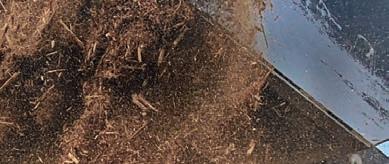









In
06 THE BREAKDOWN
Industry decision makers ponder what is the biggest challenge facing the organics industry.
08 PLASTIC POLLUTION
New science estimates up to 11 million tonnes of plastic pollution is sitting on the ocean oor.
18 CULTIVATING CHANGE
Pure Environmental demonstrates the bene ts of compost to support its uptake into agriculture.
20 GREEN CREDENTIALS
Taking the guesswork out of choosing genuinely compostable items.
23 ORGANIC OPPORTUNITIES
An in-vessel compost facility is helping meet organics recycling targets.
27 WATT’S NEXT?
Australia’s battery recycling scheme is under review to help combat market pressures for the industry.
HSR Southern Cross has toiled with hearts and hands to set benchmarks in the waste equipment sector.
“STAYING AHEAD OF INDUSTRY TRENDS AND CUSTOMER EXPECTATIONS HAS POSITIONED HSR SOUTHERN CROSS AS A TRUSTED NAME IN THE WASTE EQUIPMENT SECTOR.”
- Jake Henderson, National General Manager of Sales and Business Development
27 WATT’S NEXT?
Australia’s battery recycling scheme is under review to help combat market pressures for the industry.
31 SOLID FOUNDATIONS
An iconic project in South Australia highlights the potential to lift Australia’s C&D waste recovery rates.
35 PLASTIC PIPE POWER
Changing attitudes towards the importance of plastic pipes.
38 WASTE LEVY WINDFALL
Shining a light on operational purpose deductions for councils.
42 CHANGING GEARS
In-house manufacturing helps Liebherr specialist machines shift with industry.
46 A FORCE TO RECKON WITH
Bucher Municipal demonstrates its new FORCE Series 3 front loader body on IVECO ACCO.
48 TECH SUPPORT
Positioning technology is helping to extend the life of land ll cells.
50 NEW MODEL
ings are about to be shaken up with the arrival of a monster compactor.
Regulars
53 PRODUCT SPOTLIGHT
57 LAST WORD
13
COVER STORY
LANDMARK OPPORTUNITIES
this issue
Features
www.wastemanagementreview.com.au / WMR / 3

Let’s play it safe From the Editor
In 2022, batteries were removed from the environment minister’s priority list in recognition of the work by the Battery Stewardship Council (BSC) and Australia’s battery stewardship scheme, B-cycle.
Within two years B-cycle has helped establish more than 5000 community drop-o points, and injected more than $22 million into the domestic battery recycling industry.
But earlier this year, the BSC brought forward the scheme’s reauthorisation by the Australian Competition and Consumer Commission (ACCC) in light of economic circumstances and “the changing risk pro le of batteries”.
Incorrect disposal of end-of-life batteries is an increasing concern across the waste management and recycling sector. According to data, lithium-ion batteries alone are believed to have caused more than 1000 res across Australia in the past 12 months –that’s almost three res a day.
Batteries do not belong in household rubbish or recycling bins. Incorrect disposal is putting waste and recycling sta in danger – from truck drivers to workers on sorting lines – at material recovery facilities.
But how do you get the message across?
Despite a national rollout of collection recycling drop-o points, which means everyone across Australia has a local solution only a few minutes from their homes and businesses, and numerous safety campaigns from state environment protection authorities, waste associations and even re authorities, the problem is rising.
In this edition of Waste Management Review we speak with Libby Chaplin, BSC Chief Executive O cer, about the importance of increasing awareness about the scheme and its safety campaigns.
While industry and governments are aligned on the need to reduce the risk of battery res, let’s hope there’s a way to get more of the community on board.
Happy reading.
 Lisa Korycki
Lisa Korycki
CHIEF OPERATING OFFICER
Christine Clancy christine.clancy@primecreative.com.au
PUBLISHER
Sarah Baker sarah.baker@primecreative.com.au
MANAGING EDITOR
Mike Wheeler mike.wheeler@primecreative.com.au
EDITOR
Lisa Korycki lisa.korycki@primecreative.com.au
JOURNALIST
Chris Edwards chris.edwards@primecreative.com.au
DESIGN PRODUCTION MANAGER
Michelle Weston michelle.weston@primecreative.com.au
ART DIRECTOR
Blake Storey blake.storey@primecreative.com.au
DESIGN
Kerry Pert, Caterina Zappia
BRAND MANAGER
Chelsea Daniel chelsea.daniel@primecreative.com.au
p: +61 425 699 878
CLIENT SUCCESS MANAGER
Justine Nardone justine.nardone@primecreative.com.au
HEAD OFFICE
Prime Creative Pty Ltd
379 Docklands Drive Docklands VIC 3008 Australia P: +61 3 9690 8766 enquiries@primecreative.com.au www.wastemanagementreview.com.au
SUBSCRIPTIONS +61 3 9690 8766 subscriptions@primecreative.com.au
Waste Management Review is available by subscription from the publisher. e rights of refusal are reserved by the publisher
ARTICLES
All articles submitted for publication become the property of the publisher. e Editor reserves the right to adjust any article to conform with the magazine format.
COVER
Cover image: Hamish McIntosh
COPYRIGHT
Waste Management Review is owned by Prime Creative Media and published by John Murphy. All material in Waste Management Review is copyright and no part may be reproduced or copied in any form or by any means (graphic, electronic or mechanical including information and retrieval systems) without written permission of the publisher. e Editor welcomes contributions but reserves the right to accept or reject any material. While every e ort has been made to ensure the accuracy of information, Prime Creative Media will not accept responsibility for errors or omissions or for any consequences arising from reliance on information published. e opinions expressed in Waste Management Review are not necessarily the opinions of, or endorsed by the publisher unless otherwise stated.

4 � WMR � May 2024

Call: Email: Visit: 03 9706 8066 sales@appliedmachinery.com.au appliedmachinery.com.au genoxmachinery.com.au
ISSUE
FIXED STRAIGHT AWAY.
BENEFIT
LOCAL SUPPLIER
TECHNICAL SUPPORT
BACK-UP.”
At Applied, our number one priority is ensuring that our customers across the country get the machinery they need, with the support they expect. With nearly 30 years’ experience, and thousands of satisfied customers across the country we’re here for the long term. We’re a true machinery partner – just ask Steve Morriss. Real Service. Real Support. Real People. That’s Applied Thinking. “ANY
IS
THAT’S THE
OF A
WITH FULL
AND
STEVE MORRISS, CLOSE THE LOOP, SOMERTON, VIC
The Breakdown
‘The Breakdown’ is a monthly column giving industry leaders and decision makers a chance to share their views on topics central to the sector.
This month we asked: “What is the biggest challenge facing the organics industry?”



John McKew National Executive Officer
Australian Organics Recycling Association
Contamination of the feedstock stream remains the single biggest challenge facing the organics recycling industry.
There is the obvious (yet unnecessary) visual contamination – plastic bags, glass, various packaging, and almost anything else you can conceivably think of that should not be there – and then there is the contamination you cannot see, micro plastics, PFAS, and other chemicals.
Contamination is costly and difficult to manage and impossible to remove in total but has to be more effectively managed across the whole supply chain. Unless we can get a cleaner feedstock stream with reduced contamination, you cannot produce a recycled organics product that will be completely free of contamination. In the IT industry they talk about garbage in, garbage out and the same applies to recycled organics.
Virginia Brunton Principal Consultant of the Organics and Education team at MRA Consulting Group
Contamination of feedstock is the biggest challenge facing the organics industry.
Physical contamination is manageable albeit expensive and higher gate fees compensate for effort. However underlying chemical contamination is a greater and increasing threat and out of processors control.
Strict and unrealistic limits on chemicals such as PFAS may render all recycled organics fit only for landfilling.
Regulators need to take a consistent and considered approach if RO are to continue to be able to be recovered for beneficial use, particularly in agriculture.
Kali Martin General Manager – Organic Recycling WestRex Organics, a subsidiary of Pure Environmental
The challenge for the organic recycling industry is end-market establishment and consistent product quality.
The industry holds immense promise for sustainable agriculture – composting presents a vital solution to replenish soil nutrients depleted by intensive farming practices. Through education and fit-for-purpose products, we can meet the needs of farmers and other end users, driving demand for compost.
Government support and procurement strategies can further accelerate market growth. By standardising and consistently regulating quality control measures, we ensure the safety and effectiveness of compost products, building trust among consumers.
With the collaboration of the key stakeholders, we can unlock the full potential of organic recycling, supporting a more sustainable future for agriculture and the planet.
If you or someone at your organisation is an industry leader and would like to be a part of this monthly column in 2024, please get in touch with Editor, Lisa Korycki lisa.korycki@primecreative.com.au
OPINION 6 � WMR � May 2024
Image: AORA
Image: MRA Consulting Group
Image: Pure Environmental

 Lacey Webb Chief Executive Officer
Lacey Webb Chief Executive Officer
Resource
Hub
Clearly the biggest challenge right now is asbestos – if for no other reason than it’s so highly publicised. But really, I think it’s contamination more broadly and inconsistent approaches to organics across Australia. PFAS contamination is a struggle – especially in Queensland, with detection limits so low that the industry’s hands are tied in many ways.
Contamination in bins and self haul loads continue to be a struggle. The move from GO to FOGO, or the lack of movement in some regions, means that previously easily recovered GO products now need to contend with a FO portion and long-standing education that may no longer be fit-for-purpose. And depending on the state, if one region has a GO program, but their neighbour is now implementing FOGO, the messaging across a region can become muddled.
Even as we work to solve the contamination challenges, and move toward mandated FOGO in some states, who will process the materials? What offtakes will exist for the product? The lack of end markets is a notable hurdle across regional Australia, and too often still involves fire permits.
Ashley Johnston General Manager Organics
Repurpose It
One of the biggest challenges for the organics industry is community education. The rollout of Food Organics, Garden Organics (FOGO) bins across the country is a commendable initiative for waste reduction, but its success hinges on effective communication.
We need to help bridge the knowledge gap among households regarding what materials can go into their FOGO bins, especially with there being differences between each council. Misinformation or lack of awareness can lead to misunderstanding on what item can put in FOGO bins.
The challenge is intensified by the need to alter long-standing waste disposal habits and misconceptions about organic waste.
We need to create clear, consistent, engaging communications and ongoing educational efforts to ensure widespread understanding and participation in FOGO recycling.
OPINION www.wastemanagementreview.com.au / WMR / 7
Image: Resource Hub
Image: Repurpose It
A reservoir for
plastic pollution
New science estimates up to 11 million tonnes of plastic pollution is sitting on the ocean floor.

Every minute, a garbage truck’s worth of plastic enters the ocean. With plastic use expected to double by 2040, understanding how and where it travels is crucial to protecting marine ecosystems and wildlife.
Dr Denise Hardesty, Senior Research Scientist with the Commonwealth Scienti c and Industrial Research Organisation (CSIRO), said new research by the agency and the University of Toronto in Canada, is the rst estimate of how much plastic waste ends up on the ocean oor, where it accumulates before being broken down into smaller
pieces and mixed into ocean sediment.
“We know that millions of tonnes of plastic waste enter our oceans every year but what we didn’t know is how much of this pollution ends up on our ocean oor,” Dr Hardesty said.
“We discovered that the ocean oor has become a resting place, or reservoir, for most plastic pollution, with between three to 11 million tonnes of plastic estimated to be sinking to the ocean oor.
“While there has been a previous estimate of microplastics on the sea oor, this research looks at larger items,
from nets and cups to plastic bags and everything in between.”
Alice Zhu, a PhD Candidate from the University of Toronto who led the study, said the estimate of plastic pollution on the ocean oor could be up to 100 times more than the amount of plastic oating on the ocean’s surface.
“ e ocean surface is a temporary resting place of plastic so it is expected that if we can stop plastic entering our oceans, the amount would be reduced. However, our research found that plastic will continue to end up in the deep ocean, which becomes a permanent
FEATURE NEWS 8 � WMR � May 2024

resting place or sink for marine plastic pollution,” Zhu said.
Scienti c data was used to build two predictive models to estimate the amount and distribution of plastic on the ocean oor – one based on data from remote operated vehicles (ROVs) and the other from bottom trawls.
Using ROV data, three to 11 million metric tonnes of plastic pollution is estimated to reside on the ocean oor.
e ROV results also reveal that plastic mass clusters around continents – about half (46 per cent) of the predicted plastic mass on the global ocean oor
resides above 200 metres depth. e ocean depths, from 200 metres to as deep as 11,000 metres contains the remainder of predicted plastic mass (54 per cent).
Although inland and coastal seas cover much less surface area than oceans (11 per cent vs 56 per cent out of the entire Earth’s area), these areas are predicted to hold as much plastic mass as does the rest of the ocean oor.
“ ese ndings help to ll a longstanding knowledge gap on the behaviour of plastic in the marine environment,” Zhu said. “Understanding
the driving forces behind the transport and accumulation of plastic in the deep ocean will help to inform source reduction and environmental remediation e orts, thereby reducing the risks that plastic pollution may pose to marine life.”
e article, Plastics in the deep sea – A global estimate of the ocean oor reservoir, was published in Deep Sea Research Part I: Oceanographic Research Papers. is research is part of CSIRO’s Ending Plastic Waste Mission, which aims to change the way we make, use, recycle and dispose of plastic.
www.wastemanagementreview.com.au / WMR / 9
Every minute, a garbage truck’s worth of plastic enters the ocean.
Image: Rich Carey / shutterstock.com
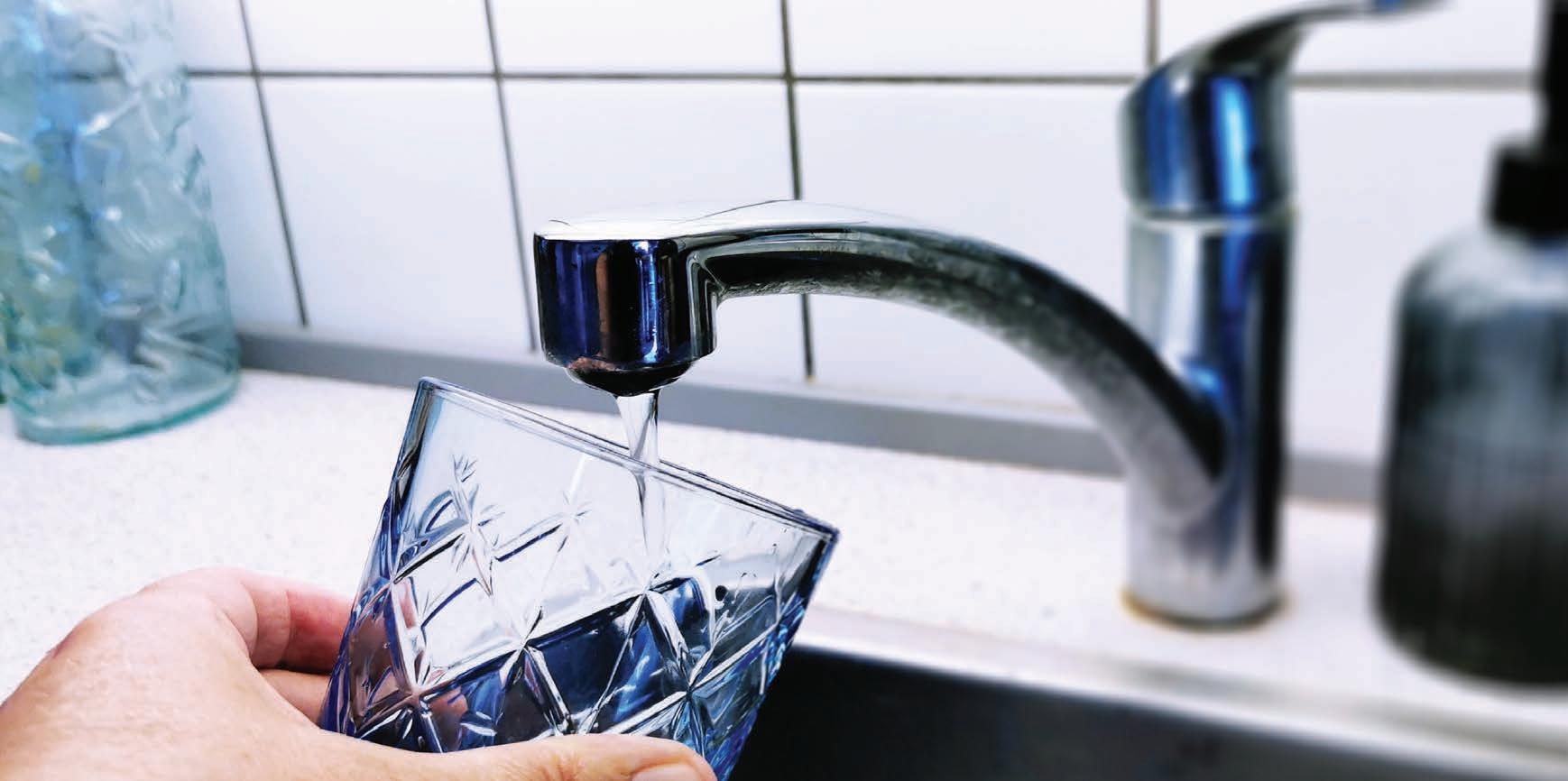
PFAS detection
A new sensor detects harmful ‘forever chemicals’ in drinking water
Chemists have designed a sensor that detects tiny quantities of per uoroalkyl and poly uoroalkyl substances (PFAS) – chemicals found in food packaging, nonstick cookware, and many other consumer products.
Also known as ‘forever chemicals’ because they don’t break down naturally, PFAS have been linked to a variety of harmful health e ects.
Using the new sensor technology, researchers at the Massachusetts Institute of Technology showed that they could detect PFAS levels as low as 200 parts per trillion in a water sample.
e device they designed could o er a way for consumers to test their drinking water, and be useful in industries that rely heavily on PFAS chemicals, including the manufacture of semiconductors and re ghting equipment.
“ ere’s a real need for these sensing technologies. We’re stuck with these chemicals for a long time, so we need to be able to detect them and get rid of them,” says Timothy Swager, the John D. MacArthur Professor of Chemistry
at MIT and the senior author of the study. Other authors of the paper are former MIT postdoc and lead author Sohyun Park and MIT graduate student Collette Gordon.
SENSOR TECHNOLOGY
Coatings containing PFAS chemicals are used in thousands of consumer products. In addition to nonstick coatings for cookware, they are commonly used in water-repellent clothing, stain-resistant fabrics, grease-resistant pizza boxes, cosmetics, and re ghting foams.
PFAS have been in widespread use since the 1950s and can be released into water, air, and soil, from factories, sewage treatment plants, and land lls. ey have been found in drinking water sources in all 50 states across the United States.
A 2011 University of Queensland survey of PFAS levels in drinking water in Australia showed that no levels exceeded the limits in the Australian Drinking Water Guidelines. e survey demonstrated that very low levels of PFAS are detectable in drinking water
around Australia. e study also detected PFAS in bottled water.
In 2023, the US Environmental Protection Agency determined “health advisory levels” for two of the most hazardous PFAS chemicals, known as per uorooctanoic acid (PFOA) and per uorooctyl sulfonate (PFOS), in drinking water, setting them at 0.004 parts per trillion and 0.02 parts per trillion, respectively.
Currently, the only way that a consumer could determine if their drinking water contains PFAS is to send a water sample to a laboratory that performs mass spectrometry testing. at can take several weeks and costs hundreds of dollars.
To create a cheaper and faster way to test for PFAS, the MIT team designed a sensor based on lateral ow technology – the same approach used for rapid Covid-19 tests and pregnancy tests. Instead of a test strip coated with antibodies, the new sensor is embedded with a special polymer known as polyaniline, which can switch between

FEATURE NEWS 10 � WMR � May 2024

semiconducting and conducting states when protons are added to the material. e researchers deposited these polymers onto a strip of nitrocellulose paper and coated them with a surfactant
that can pull uorocarbons such as PFAS out of a drop of water placed on the strip. When this happens, protons from the PFAS are drawn into the polyaniline and turn it into a conductor, reducing the electrical resistance of the material. is change in resistance, which can be measured precisely using electrodes and sent to an external device such as a smartphone, gives a quantitative measurement of how much PFAS is present.
is approach works only with PFAS that are acidic, which includes two of the most harmful PFAS – PFOA and per uorobutanoic acid (PFBA).
A USER�FRIENDLY SYSTEM
e current version of the sensor can detect concentrations as low as 200 parts per trillion for PFBA, and 400 parts per
trillion for PFOA using only a fraction of a millilitre of water. e researchers are working on a larger-scale device that would be able to lter about a litre of water through a membrane made of polyaniline. ey believe this approach should increase the sensitivity by more than a hundredfold.
Such a device could o er a less expensive, rapid alternative to current PFAS detection methods. If PFAS are detected in drinking water, there are commercially available lters that can be used on household drinking water to reduce those levels.
e new testing approach could also be useful for factories that manufacture products with PFAS chemicals, so they could test whether the water used in their manufacturing process is safe to release into the environment.

SHAPE THE FUTURE OF
Learn more and get in touch today aptella.com
RESPONSIBLE WASTE MANAGEMENT
A new sensor developed by chemists could offer a cheap, fast way to test for PFAS in drinking water.
Image: P. Qvist / shutterstock.com
One of Australia’s leading recycling and waste management companies
One of Australia’s leading recycling and waste management companies
BINGO services the building & demolition and commercial & industrial sectors across the east coast of Australia
BINGO services the building & demolition and commercial & industrial sectors across the east coast of Australia
Our focus is to use sustainable, recycling-led solutions to divert valuable waste materials from land ll
Our focus is to use sustainable, recycling-led solutions to divert valuable waste materials from land ll
BINGO supports our customers to achieve their sustainability objectives and maximise resource recovery
BINGO supports our customers to achieve their sustainability objectives and maximise resource recovery

Scan to learn more
Scan to learn more




BINGO focuses on diverting waste material from land ll. Our network of advanced recycling facilities creates a range of recycled products that can be used in place of precious virgin material.
BINGO focuses on diverting waste material from land ll. Our network of advanced recycling facilities creates a range of recycled products that can be used in place of precious virgin material.





At the crux
HSR Southern Cross has toiled with hearts and hands to set benchmarks in the waste equipment sector. Now, the stars have aligned as the Australian-owned company lays out an ambitious roadmap to expansion.
Eective waste management is a crucial aspect of any operation, regardless of size. Providing tailored waste solutions has been the driving force behind HSR Southern Cross since its inception in 2002.
Founder Martyn Cross recognised the need for a company that not only delivered top-notch products and services but prioritised customer satisfaction and innovation.
More than two decades later, his vision to create a dynamic organisation that could rede ne the standards of waste industry service and manufacturing has come to life and is on the cusp of expansion.
Jake Henderson, National General Manager of Sales and Business
Development, says HSR Southern Cross has built a foundation rooted in quality, reliability, and a passion for waste equipment manufacturing excellence. A commitment to these principles has played a pivotal role in the company’s growth and success.
“ e founding principles not only shaped the company’s identity but continue to guide its operations,” Jake says. “Staying ahead of industry trends and customer expectations has positioned HSR Southern Cross as a trusted name in the waste equipment sector.”
e family-owned business in Western Sydney is an Australian-owned and certi ed manufacturer of hook loaders, skip loaders, tarping systems, and rear-
load refuge compactors. With more than 120 years of combined knowledge in engineering, design, and manufacture, it o ers a national network of distributors and approved service partners from the Pilbara to Launceston and everywhere in between.
It caters to a diverse range of businesses and organisations – from waste management companies to municipal councils and commercial enterprises involved in waste collection and disposal – that rely on e cient truck-mounted waste equipment.
Jake says understanding that waste management demands vary across industries and sectors allows HSR to serve both public and private sector clients. e company has collaborated with
COVER STORY www.wastemanagementreview.com.au / WMR / 13
HSR Southern Cross has built a reputation on manufacturing products tailored to customer needs.
Images: Hamish McIntosh
businesses of di erent scales, from small enterprises to large corporations. And because its products and solutions cater to the speci c needs of each customer, each piece of equipment meets the stringent requirements of various applications.
He says lasting relationships have been built with a broad spectrum of clients because of HSR’s commitment to providing tailored solutions and exceptional customer service.
“We understand that our success is intrinsically linked to the satisfaction of our clients,” Jake says. “ erefore, we go above and beyond to provide exceptional support, ensuring that every customer interaction with HSR is marked by professionalism, responsiveness, and a genuine commitment to their needs.”
Meeting those needs and manufacturing equipment that stands up to Australia’s harsh conditions means a continual process of re nement. HSR doesn’t rest
on its laurels but actively seeks ways to enhance its products and services.
Jake says the expert team takes pride in o ering truck-mounted waste equipment that is 100 per cent Australian-made and designed. is ensures a level of quality and re ects a dedication to precision and craftsmanship. It also means clients bene t from cutting-edge solutions that re ect the latest advancements in the industry.
“We don’t just meet standards; we set them,” he says. “We are consistently pushing the boundaries to set new benchmarks in the industry.
“HSR’s products are not just solutions; they are tailored responses to the dynamic and evolving needs of our customers in the waste management industry.”
TURNKEY SOLUTIONS
Responding to industry needs has resulted in a dynamic partnership between HSR
and Wagga Isuzu. Over the past three years, this partnership has lled a gap in the market and left an indelible mark on the industry, selling more than 140 vehicles to customers across Australia.
Luke Harris, Isuzu Trucks Sales Manager, says by pooling their resources and knowledge, Wagga Motors and HSR have provided the market with a turnkey solution for waste vehicles. is approach meant that customers no longer had to endure lengthy waiting periods or navigate the complexities of piecemeal solutions. Instead, they could turn to Wagga Motors and HSR to deliver fully assembled, ready-to-use waste vehicles promptly and e ciently.
What sets the collaboration apart, Luke says, is its unwavering commitment to customer satisfaction.
“Recognising the inherent challenges faced by businesses in the waste management sector, Wagga Motors and

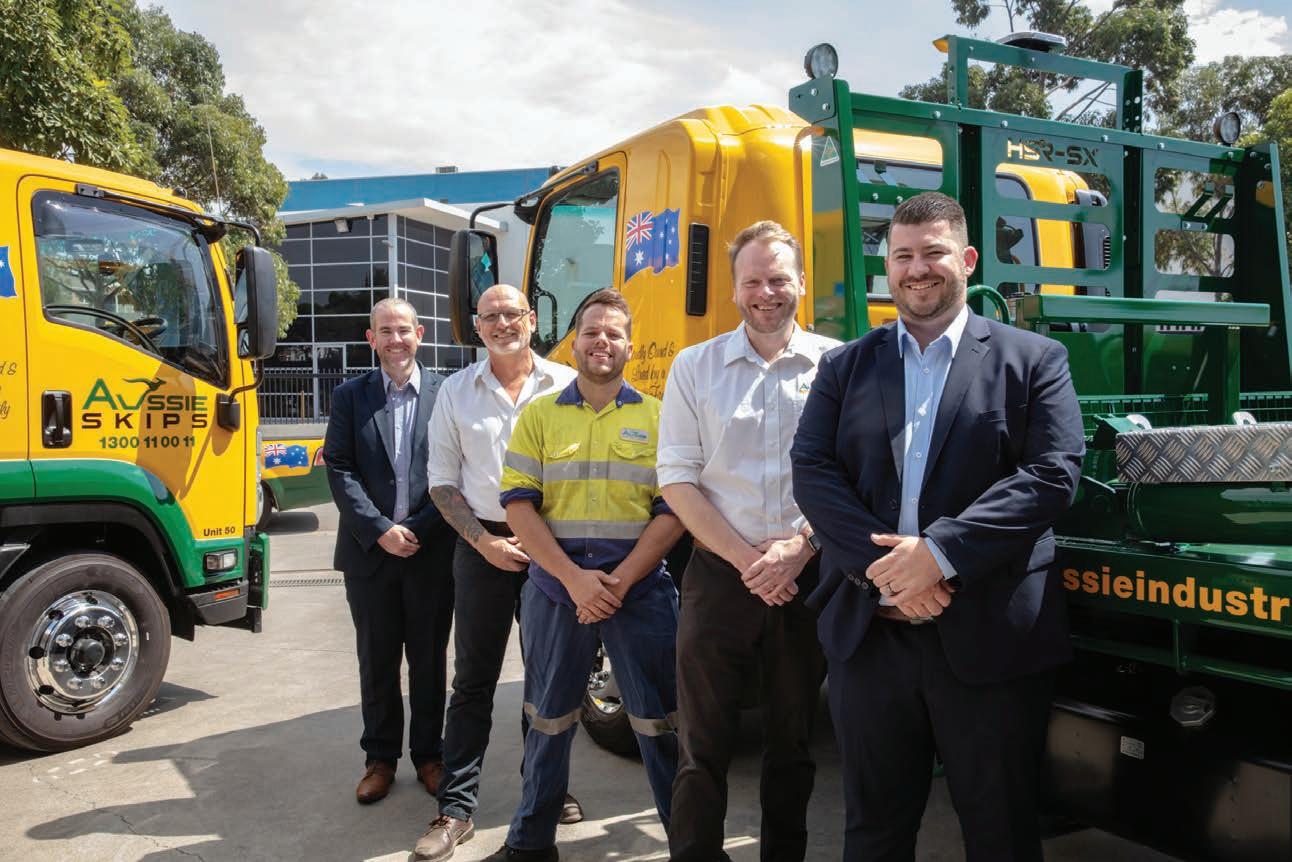
COVER STORY 14 � WMR � May 2024
Aussie Industries has purchased two HSR -SX 85 (Isuzu FSR 4x2) skip loaders, which will be used to navigate tight spaces within the inner Sydney area.

HSR sought to alleviate these burdens by o ering a one-stop service,” he says. “From procurement to customisation, from assembly to delivery, every step of the process is seamlessly integrated, ensuring a hassle-free customer experience.
“Moreover, the bene ts extend beyond convenience. e competitive pricing o ered by Wagga Motors and HSR makes quality waste vehicles accessible to a wider range of businesses. By prioritising a ordability without compromising on quality, they have democratised access to essential equipment, empowering businesses of all sizes to enhance their operations e ectively.”
Looking ahead, Luke says the future appears bright for Wagga Motors and HSR. Buoyed by their shared successes and fuelled by a pursuit of excellence, they remain committed to pushing the boundaries of innovation and rede ning service standards in the waste management sector.
“One thing remains certain: wherever there are challenges, opportunities, and a need for innovative solutions, Wagga Motors and HSR will be at the forefront, driving progress and transforming industries.”
DRIVING PROGRESS
e waste management industry has undergone signi cant transformations over the years. Smart waste management, sustainability and recycling initiatives, circular economy practices and alternative waste-to-energy solutions are all on the radar.
e regulatory environment continues to evolve. HSR works with regulatory bodies to stay informed of changes and ensure its products comply with the latest industry standards.
Customer needs and preferences are more diverse and specialised. Recognising the importance of customisation, HSR products are designed to be highly adaptable.
Jake says that the need for skilled personnel has also become crucial as the industry changes. In response, HSR has expanded its commitment to customer support and training programs. It o ers comprehensive training for its customers’ teams, providing the necessary skills to operate and maintain equipment e ectively.
“Our adaptability is a testament to our commitment to meeting the evolving needs of our customers and the dynamic challenges of the waste management sector,” he says.
And when it comes to challenges, there have been a few that have pushed the boundaries in terms of schedule and ability.
In the instance of tight deadlines, the company has optimised its production processes. It has also worked closely with the customer to meet delivery deadlines without compromising quality.
is is one area where the partnership with Wagga Motors plays an active role.
www.wastemanagementreview.com.au / WMR / 15
Luke Harris, Isuzu Trucks Sales Manager Wagga Motors; Drew Robinson, Fleet Manager Aussie Industries; Scott Palmer, Head Mechanic Aussie Industries; Mitchell Palmer, Co-Chief Operating Officer, Aussie Industries; and Jake Henderson, National General Manager Sales and Business Development HSR Southern Cross.
“Luke’s ability to source a chassis at the drop of a hat gives us the ability to achieve great results with tight schedules,” Jake says. “ is is a win-win relationship for both parties and one that will continue for a long time.”
Some customers have requested technical requirements that demand specialised engineering solutions. HSR leverages in-house expertise to develop custom solutions.
“In each of these scenarios, our approach has been rooted in collaboration and a deep understanding of our customers’ needs,” Jake says. “We actively engage with our clients throughout the process, ensuring that their feedback is incorporated and that the nal product not only meets but exceeds their expectations.”
CUSTOMER SATISFACTION
Mitchell Palmer is the Co-Chief Operations O cer of Aussie Industries, a family-owned business that specialises in skip bin hire across Greater Sydney.
e company boasts a eet of more than 4500 skip bins and 85 vehicles.
e latest acquisition, two HSR -SX 85 (Isuzu FSR 4x2) skip loaders, will be used to navigate tight spaces within the inner Sydney area.
Mitchell says selecting the HSR truck was a straightforward decision. It was the standout choice upon comparison, o ering a two-year structural warranty, reinforced large bin stops that ensure team safety during operations but also safeguard the truck cabin, and strategically installed cylinder covers that provide additional protection for crucial lift and extension mechanisms.
But what drew them to HSR was aligning with Aussie Industries’ values and priorities – being Australian-owned and operated, committed to quality products, and investing in local talent to support communities.
“We’ve engaged HSR’s expertise on multiple occasions, speci cally for
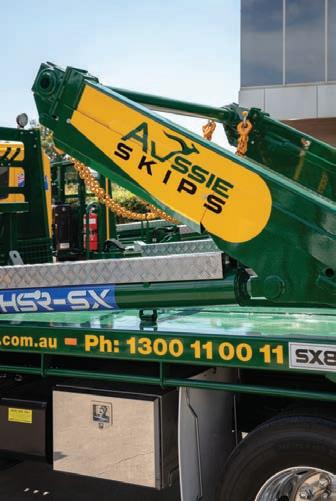
hydraulic servicing and tarping systems support, including some challenges where other body manufacturers no longer provided parts or service,” Mitchell says.
“In each instance, the HSR team has exceeded our expectations, demonstrating unparalleled dedication to ensuring quick problem resolutions and keeping our eet on the road.
“ eir commitment and proactive approach to addressing our needs have been instrumental in maintaining the e ciency and reliability of our operations. It’s a partnership we deeply value and one that continues to foster mutual success.”
LOOKING AHEAD
What does future success look like?
HSR has a strategic roadmap to fortify its market presence over the next decade.
ere are plans to expand the sales team and establish service and tting facilities nationwide to bolster the company’s outreach and strengthen customer relations. Jake says this geographical diversi cation will ensure that every customer, regardless of location, receives dedicated and con dent service and product support, fostering stronger connections and trust.

HSR is gearing up for the introduction of innovative compaction bodies, broadening its product range to cater to an even wider spectrum of waste management needs. It’s also dedicated to ongoing improvement and augmentation of existing product o erings with a commitment to incorporating technological advancements, re ning designs and responding to emerging industry trends.
e goal is to provide products that set benchmarks in e ciency and reliability. at will involve investment in research and development.
“ is initiative aims to foster innovation, explore new technologies, and stay ahead of the curve in anticipating and addressing the evolving needs of the waste management sector,” Jake says.
“We have ambitious goals that re ect our commitment to growth, innovation, and industry leadership.
“In 10 years, we aspire to see HSR as a nationally recognised and in uential player in the waste management sector, setting new standards for excellence and sustainability.”
For more information, visit: www.hsrsx.com.au

COVER STORY 16 � WMR � May 2024
Aussie Industries has a long association with HSR.
HSR is proud to be Australianowned and operated.

Cultivating change
Pure Environmental demonstrates the benefits of compost to support its uptake into agriculture.
Organics recycling has been identi ed as a signi cant opportunity for diversion of waste from land lls, and it forms a vital part of national and state circular economy strategies.
Kali Martin, General Manager of Organics for Pure Environmental, says it’s also one of the most fundamental ways to replenish soils for Australia’s food production.
“ ere is limited capacity for Australian soils to continue growing food,” Kali says.
“You can’t continue to pull resources out of the soil forever. What legacy are we leaving for future generations if we’re not putting something back?”
While compost is relatively new for many, Kali says there’s a quiet evolution unfolding. Faced with frequent extreme
weather events and rising fertiliser prices, a new generation of farmers recognises the need to do things di erently.
Compost allows farmers to optimise what they get from soil by building up its quality and structure. And that’s where Pure Environmental comes in.
e team has extensive experience in the organic recycling industry, producing high quality compost, tested to Australian Standards.
Pure Environmental is selective about the feedstocks and the recipe for its compost. It’s also strict on quality assurance and monitoring to ensure optimal conditions for composting are maintained throughout the process.
It has the bene t of space and time to process material to a stabilised and mature compost. Two things that can a ect the quality of the product.

Kali says a short processing time could mean compost is still breaking down when it’s sent to market, and the nutrients are not yet plant-available.
“We only compost a smaller range of feedstocks and go through a quality assurance process for any new feedstock that we are going to start to accept,” Kali says.
“We need to understand a lot about that feedstock, how it’s generated, and any potential for contamination. All material is laboratory tested, and only materials that are assessed and approved are allowed on site.”
Operating within a 3000-acre sheep and cattle farm in Queensland’s food bowl, Pure Environmental’s organics recycling facility is the perfect proving ground for its compost. It is also here that the company recently hosted a demonstration day for local farmers to spread the message.
Agronomists from RAFF Group provided an overview of how and why farmers could use compost, and equipment company Wideland Group provided a demonstration on the application of compost to paddocks. e demonstration day was designed to give an overview of compost, its bene ts and how to apply it. Pure Environmental also opened a trial area on the farm for attendees to see the results.
“We had farmers who understood the general bene t of using compost but didn’t necessarily know who to get advice from or how to apply or spread it on their paddocks,” Kali says.
“ e discussions were passionate, and people were so interested. It’s a slowmoving process, which is understandable;
FEATURED TOPIC � ORGANICS 18 � WMR � May 2024
A Demonstration Day held at the WestRex Organics facility in Leyburn, Queensland, gave farmers an overview of the composting process. Image: Pure Environmental.
for farmers, this is their livelihood. ey need to really understand what compost is to make a change.
“We wanted to help them understand those things and build more awareness because we know our product can bene t them.”
And what are the bene ts?
Compost provides a source of organic matter including carbon; building soil carbon improves soil structure and its ability to hold nutrients and water. Compost also provides microbial activity and a range of micronutrients.
Kali says water retention is a big concern for farmers. Following a drought, soil can be poor quality and compacted. If there is a rainfall event, the rain will wash o , but soil that has a compost amendment and structure is able to hold onto the moisture for some time.
Increased microbial activity has a range of bene ts, including making the soil more resilient to pests and diseases. Compost can also work in unison with fertiliser to optimise its e ectiveness.
In 2023, the Queensland Department of Environment and Science held several workshops to address farmer demand and market speci cations for organic composts and materials.
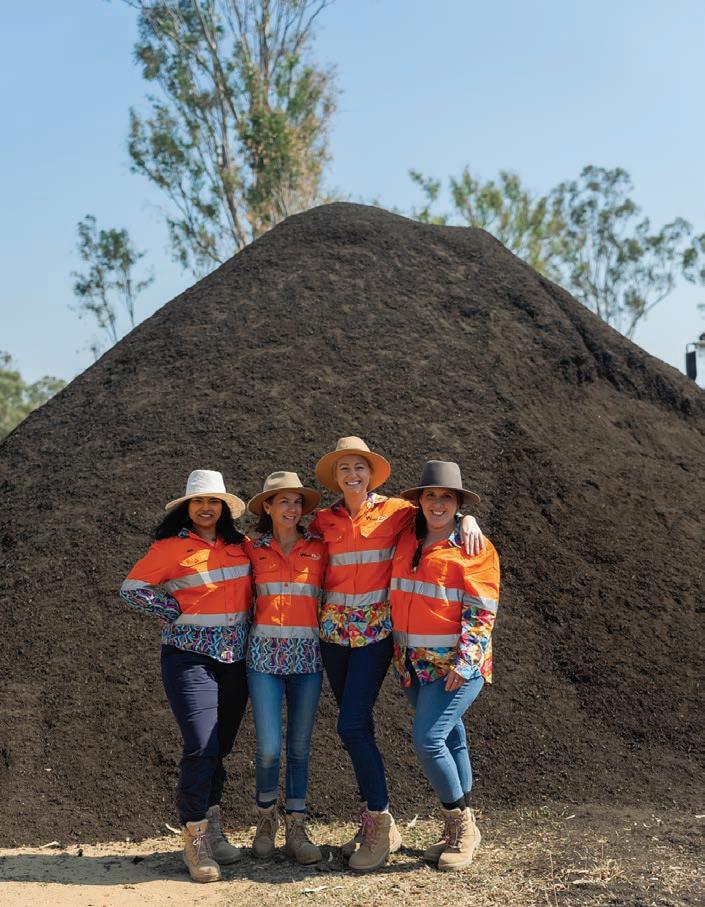
At the time, John McKew, the Australian Organics Recycling Association (AORA) National Executive O cer, described compost as a highly renewable resource for maintaining and improving agricultural production. e time was right to start the conversation and education on the role of compost in

agriculture. Kali and Pure Environmental share this passion. Kali sits on the AORA board and chairs several Queensland organics working group activities.
She says one area of focus for the industry is having contemporary speci cations that meet current industry needs in terms of incorporating new research and understanding about quality and contaminants.
“For the industry to grow, mature, and succeed, we also need to ensure these speci cations are used consistently across the country,” Kali says. “We want to encourage processors to understand their market and ensure that they have adequate quality assurance programs in place to produce t-forpurpose products.
“ ere are signs that things are changing. For our industry that means the market is going to continue to grow, and that’s positive for everyone.”
For more information, visit: www.purenv.com.au
www.wastemanagementreview.com.au / WMR / 19
Kali Martin, General Manager of Organics for Pure Environmental (second from left) and the team behind WestRex Organics’ compost. Image: Wideland Group.
Compost is loaded into equipment in preparation for spreading. Image: Pure Environmental.

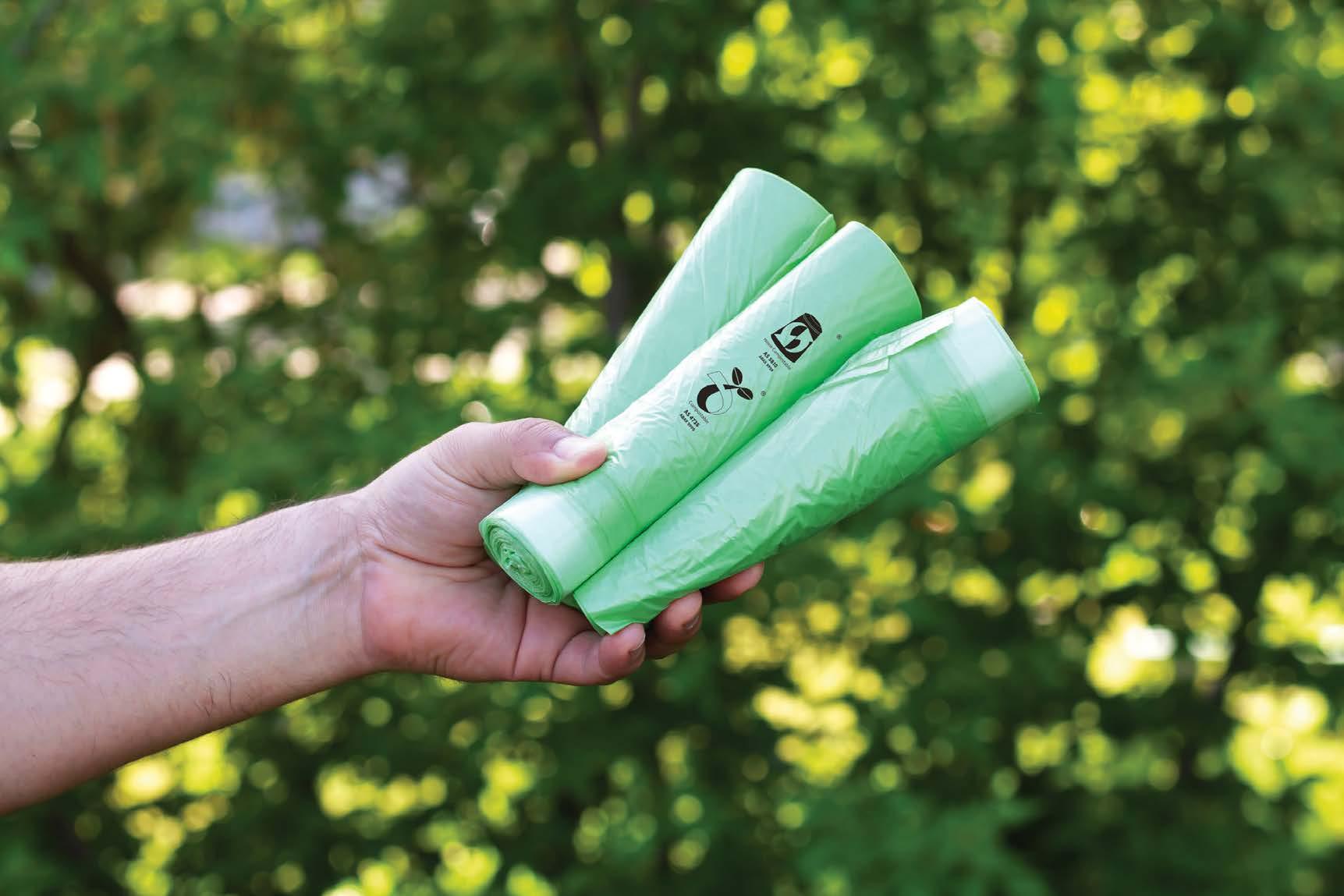
Green credentials
The Australasian Bioplastics Association is taking the guesswork out of choosing genuinely compostable items so everyone can compost with confidence.
As Australia transitions to a circular economy and aims for net zero emissions, more consumers are making choices based on sustainability. Ensuring any environmental claims are backed up by robust evidence is critical for businesses that want to avoid any hint of greenwashing, says Rowan Williams.
e President of the Australasian Bioplastics Association (ABA) says veri cation and labelling are key to providing clarity for consumers and can help organisations achieve sustainable procurement goals.
He says there’s likely to be an increasing focus on claim veri cation and the authenticity of claims as the push towards transparency and reporting in the circular economy continues.
e ABA has been the peak body for the bioplastics industry in Australia and New Zealand since 2006, promoting the appropriate use of bioplastics that are certi ed compostable, based on renewable resources, or both.
Membership is from across the spectrum of the bioplastics industry, including manufacturers, converters, and distributors of bioplastic products and materials throughout the region.
Alongside its member-based activities, the ABA also administers several voluntary veri cation schemes, for companies or individuals who want to have their compliance to standards veri ed.
e schemes include one for Australian Standard (AS)47362006 – Biodegradable plastics suitable for composting and other
microbial treatment; AS5810-2010 –Biodegradable plastics suitable for home composting; and the newest – launched in 2023 – for ISO 23517:2021 –Plastics. Soil biodegradable materials for mulch lms for use in agriculture and horticulture.
“Voluntary veri cation schemes, such as those administered by the ABA, are an e ective tool for all parts of the organics recovery value chain to easily identify certi ed compostable and certi ed soil biodegradable items and ensure that the product meets the requirements for the intended end of life recovery,” Rowan says.
“Most people are probably more familiar with the veri cation schemes than they think, through seeing the associated logos on everyday items.”
FEATURED TOPIC � ORGANICS 20 � WMR � May 2024

Each veri cation scheme can support circularity and the organics value chain in di erent ways. e most familiar is the ‘commercial’ AS47362006 certi cation and corresponding ‘Australasian seedling’ logo.
To be certi ed compostable and carry the seedling logo, items considered suitable for veri cation must undergo a stringent test regime outlined by AS4736 and carried out by independent accredited laboratories.
e seedling logo is used on, among other items, certi ed compostable food organic, garden organic (FOGO) caddy liners, certain food service ware items, and food packaging, helping millions of Australians divert more kitchen waste.
“Data and qualitative feedback have consistently shown throughout the past 20 years that certi ed compostable
caddy liners increase the capture rate for kitchen organics,” Rowan says. “ ey remove the yuk factor barrier at household level and facilitate e ective engagement with the FOGO service.
“Where certi ed compostable liners are supplied, councils enjoy a higher capture rate of organics to FOGO, by up to 30 per cent, than those that don’t supply, or are unable to accept, certi ed liners.”
He says veri cation of the liners via the AS4736 and AS5810 programs means that every part of the value chain can be con dent that the claims of compostability have been veri ed as meeting the requirements of AS4736 and AS5810.
e ‘seedling’ logo is a quick and easy way of identifying certi ed compostable products. at means consumers know which liners to buy (or not), as do councils.
“Importantly, organics recyclers, and anyone wanting to safely and hygienically manage food waste in a home compost system, can be con dent that the certi ed liners will break down completely into water, carbon dioxide and biomass,” Rowan says. “Veri cation also signals that no added Per-and poly uoroalkyl substances (PFAS) are present. is in turn helps to support the organics recycling industry to continue to produce high quality materials, which we know is important in maintaining the sustainability of compost end markets.”
e AS5810 ‘home compostable’ veri cation scheme works in a similar way, and the logo is often found on items such as certi ed compostable food packaging, co ee cups, and cling lm, signalling the item’s suitability for home composting.
Rowan says AS4736 and AS5810 are the most stringent in the world, with an earthworm ‘ecotoxicity test’ that is not necessarily required in other jurisdictions today but is coming.
In 2023, a third veri cation program was added by the ABA, for Certi ed Soil Biodegradable Mulch Film. is program, Rowan says, can change the game on how problematic plastics are managed on farms across the country.
Every year in Australia, the agriculture and horticulture sectors use about 200,000 kilometres of single-use plastic mulch lm – enough to reach around the Earth ve times. At the end of each growing season, it’s gathered up and disposed of – bringing a huge labour cost with it.
More than 86 per cent isn’t recycled, leaving signi cant amounts of lm to be disposed of in other ways such as burning or land ll. If left in the soil, conventional mulch lms will break down into harmful microplastics.
So, how can these issues be overcome?
Rowan says bioplastic mulch lm certi ed to ISO 23517 helps avoid or eliminate many of these problems. is certi ed mulch lm is designed to biodegrade in-situ, and the certi cation means that farmers can be con dent that the lm will fully biodegrade without harmful e ects, or any microplastics being deposited in the soil.
“ e savings in labour and proper disposal costs are signi cant, and simplifying on-farm waste management is always going to be popular with farmers,” he says.
“ e need to recover, store, transport, and dispose of a signi cant amount of pre-farm gate waste is circumvented, with no harmful e ects on the soil.
Additionally, the cost of inappropriate disposal of conventional plastic lm which is rarely properly accounted for in terms of environmental cost, such as burning or dumping down mine shafts, is avoided.”
For more information, visit: www.bioplastics.org.au
www.wastemanagementreview.com.au / WMR / 21


Organic opportunities
In-vessel composting helps meet state organics recycling targets.

Food and organics waste in land ll are signi cant greenhouse gas emitters.
Recognising the importance of the growing organics recycling sector, in 2021 the Federal Government launched a $171 million fund to take 3.4 million tonnes of food and organics waste out of land ll each year and return it to the soil.
Across Australia, Victoria has the highest level of food waste, with 2.4 million tonnes of waste each year, according to Sustainability Victoria.
e State Government’s waste policy aims to divert 80 per cent of waste from land ll by 2030 and includes initiatives that seek to increase the reuse,
repurpose, and recycling of materials such as Food Organics, Green Organics (FOGO) waste.
PARTNERS OF CHANGE
Resource recovery leader Repurpose It already plays a role in delivering on the state’s waste targets, with the company’s Epping base declared a site of strategic importance by the government.
In 2021, Repurpose It set out to revolutionise the FOGO recycling industry. e centrepiece is a 3000-square metre organics facility. e company commissioned MECBIO to design and build an invessel organic waste composting facility,
capable of processing FOGO into highgrade compost.
MECBIO is a full-service provider for the recovery of organic, construction and demolition and plastics waste. Its technologies cover a range of recycling solutions including aerobic biodrying, anaerobic digestion or biogas production, air treatment and odour control systems, plastics recycling plants, mechanical pre-treatment and post-treatment, waste sorting plants, and more.
MECBIO partners with global suppliers to assist Australia’s transition to a circular economy. Waste Treatment Technology (WTT) is its technology partner for building sustainable and state-of-the-art organic waste treatment facilities such as in-vessel composting.
Based out of the Netherlands, WTT has designed and built more than 1509 organics waste processing facilities across the world.
THE SOLUTION
Dean Dowie, Chief Executive O cer and Managing Director of MECBIO, says the company was happy to assist in building an in-vessel composting (IVC) plant for Repurpose It.
e brief was for a facility that met volumetric and qualitative requirements and included aeration systems within tunnels and complete leachate management and odour control systems
“IVC ensures that composting takes place in an enclosed environment, with accurate temperature control and
FEATURED TOPIC � ORGANICS www.wastemanagementreview.com.au / WMR / 23
MECBIO was commissioned to design and build an in-vessel organic waste composting facility at Repurpose It.
Images:
MECBIO


monitoring,” Dean says. “Odour control, legislative licensing requirements, footprint (size of the plant), throughput and product quality are considered when determining if in-vessel composting is suitable.”
e composting process takes place in completely closed (concrete) vessels, so-called tunnels. Food organics is mixed with green organics, shredded, and composted in the tunnel for an intensive phase with temperatures of more than 55 degrees Celsius killing any harmful microbes.
After a further maturation period consisting of constant mixing and checks to ensure quality, the nal compost is ready to be used as soil conditioner on farms, parks, and gardens.
e major advantages of composting in tunnels are the speed of the process as well as the ability to guarantee hygienisation and therefore the quality of the product while controlling odour.
e tunnels are individually controlled with forced aeration to process organic waste into compost. Each composting tunnel has its own aeration system, water and heating modules and is accompanied with the required instrumentation.
Process and odour control is optimal, resulting in homogenic pasteurisation and degradation of organics. e whole con guration is included into a skid for faster installation, easier transport to site and simpli ed commissioning.
e complete tunnel system is remotely actuated and controlled by a SCADA visualisation system. is allows site operators to set process parameters to be able to adapt to di erent waste streams and seasonal uctuations.
Dean is hopeful that more projects such as this will be prioritised to meet recycling targets and objectives of processing source segregated wastes from communities across Australia.
For more information, visit: www.mecbio.com.au


FEATURED TOPIC � ORGANICS 24 � WMR � May 2024
Organic waste is loaded into a bay for processing at Repurpose It.
The IVC plant includes aeration systems within tunnels and complete leachate management and odour control systems.


M&J PRESHRED 4000M MOBILE SHREDDER
The M&J PreShred 4000M is a versatile, large-capacity waste shredder designed for a broad range of materials, making it ideal for facilities dealing with inconsistent waste types, including metal, stone, and concrete.
Its robust construction suits various settings, from recycling plants processing refuse derived fuel (RDF) to hazardous waste facilities. It efficiently manages diverse waste forms such as construction debris, bulky and household refuse, chemical and industrial waste, and even challenging items like tree stumps, carpets, and compressed waste bales.






Brisbane | Sydney | Melbourne Adelaide | Perth tuttbryant.com.au 1300 658 888 Follow us on:




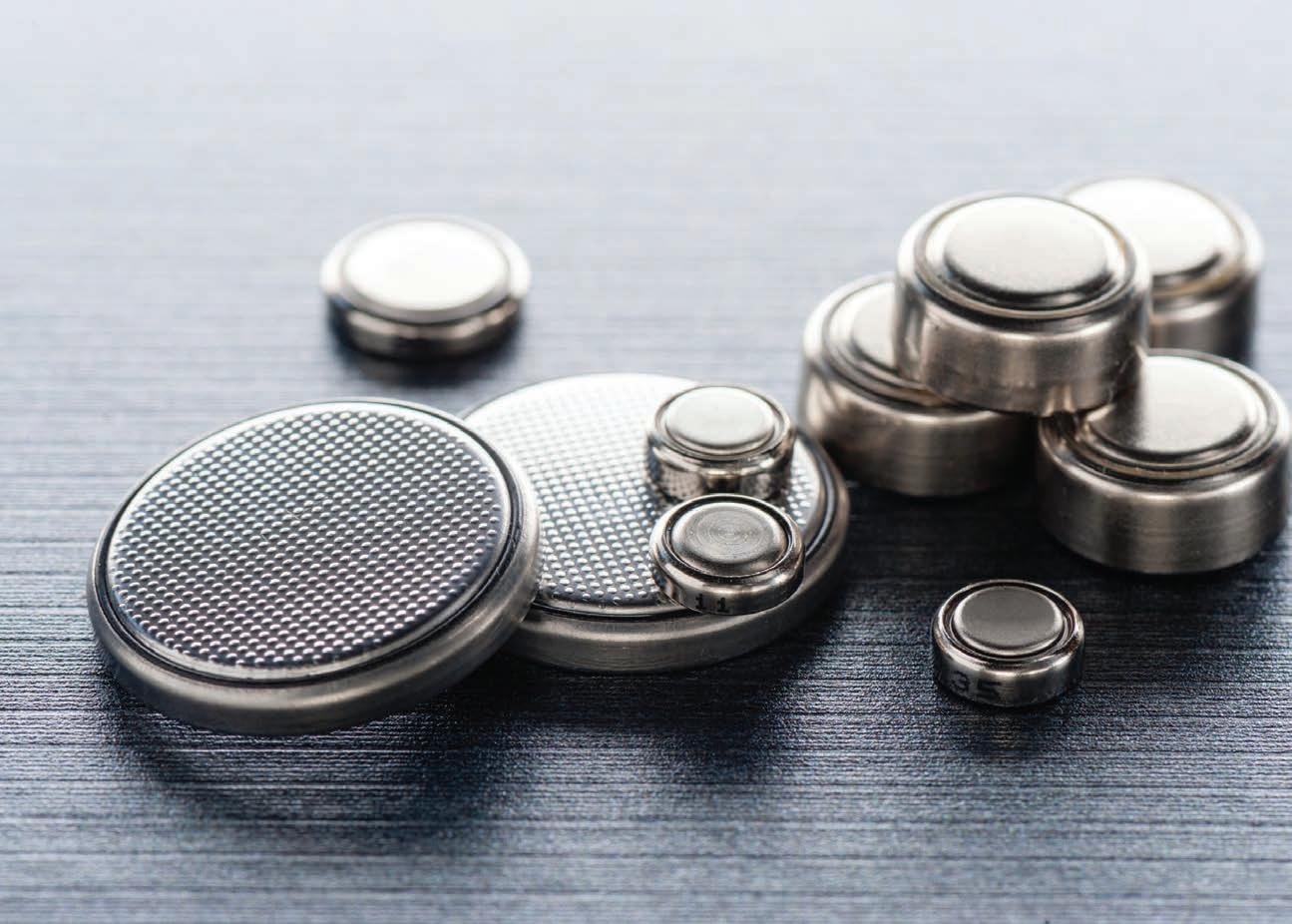
Innovative, Sustainable Waste Management Solutions
Pure Environmental is a wholly Australian-owned company founded with the mission to transform the circular economy through advanced resource recovery. We believe in pushing boundaries and challenging norms in waste management, providing exceptional, innovative, and sustainable solutions. Scan
Resource Recovery & Re-Use info@purenv.au www.purenv.au 1300 652 774 Hazardous & Regulated Waste Packaged Chemical Waste Organics Recycling
Transforming the Circular Economy
Code




Watt’s next?
Australia’s battery recycling scheme is under review to help combat market pressures for the industry.
Libby Chaplin wants to see Australia’s Battery Stewardship Scheme continue to evolve and proactively work with industry partners to address the changing risk pro le of batteries.
e Battery Stewardship Council (BSC) Chief Executive O cer announced a review of the B-cycle scheme in the face of the current downturn in the economy.
She’s con dent the review will result in improvements to the scheme to better enable B-cycle and its partners to adapt and address evolving market conditions.
“ e industry and battery chemistries are changing all the time. It’s important the scheme responds to these market
pressures and adapts accordingly,” Libby says.
“We’re taking a proactive stand to deliver our objectives and provide a platform for healthy and sustainable growth within the battery recycling industry.”
e national voluntary scheme was designed to encourage recycling and better waste management of endof-life batteries.
Launched in 2022, B-cycle has resulted in the establishment of more than 5000 community dropo points, the recycling of 4.5 million kilograms of batteries, and the injection of more than $22 million into the domestic battery recycling industry.

e scheme’s reauthorisation by the Australian Competition and Consumer Commission (ACCC) was scheduled for September 2025, but has been brought forward by the BSC Board in recognition of economic pressures. A general downturn in the economy has impacted battery sales and resulted
FEATURED TOPIC � BATTERY RECYCLING www.wastemanagementreview.com.au / WMR / 27
A proposed restructure of B-cycle would enable an increased levy on high-risk products such as button and lithium batteries. Image: Nor Gal / shutterstock.com
Libby Chaplin, Battery Stewardship Council Chief Executive Officer. Image: Battery Stewardship Council

in a reduction of revenue from the levy imposed on imports. ere are increases in fuel and labour costs for the collectors, and reductions in commodity prices for B-cycle accredited recyclers through a rebate for recycled batteries. Libby says that since the scheme was designed in 2019, Consumer Price Index (CPI) has increased by 16.8 per cent while commodity prices have reduced signi cantly.
Having established a strong foundation of the scheme, the BSC recognises a more nuanced approach is necessary, and is exploring the need for a modulated rebate to address the varying costs associated with working with di erent chemistries.
BSC has conducted economic modelling to assess the cost bene t of a
modulated levy, based on the risks. e proposed restructure would enable an increased levy on high-risk products such as lithium and button batteries.
Preliminary consultation with B-cycle participants has been conducted. Next steps are for the BSC Board to review the proposed plan, before turning to a more comprehensive consultation in May. BSC intends to complete the review and prepare a submission to the ACCC for reauthorisation before the end of 2024.
An essential feature of the scheme review is a parallel process to establish an e cient but e ective stewardship regulation that is focused on preventing freeriding, with conversations underway with government. BSC is of the view that free riders are actively engaging in anti-competitive behaviour by not
participating and failing to ensure the safe end-of-life management of their products.
“With the current market we have a very high proportion of importers in the scheme but there are some recalcitrant, steadfast organisations not participating,” Libby says. “ ey are gaining a competitive advantage over organisations that take responsibility for their products.”
e review aims to increase safety and diversion of higher risk categories such as lithium batteries and button batteries. BSC is also seeking to enhance safety infrastructure and ensure consumers understand the importance of buying good quality batteries, and their safe use, storage and recycling.

FEATURED TOPIC � BATTERY RECYCLING 28 � WMR � May 2024
The Battery Stewardship Council is seeking to enhance safety infrastructure for battery recycling. Image: Sahan Nuhoglu / shutterstock.com
A strong focus of the scheme is safety at all stages. is starts with B-cycle working with drop-o points to establish their own risk assessments and safety plans, and more than 1000 frontline sta receiving B-cycle drop-o point safety training.
e collection containers provided for retail drop-o points have been installed with re detection monitoring that alerts the collector and the store in the unlikely event of a re-related incident. ese containers and their kiosks have been imported from Europe where they were designed for safe battery collection by Bebat, one of the most successful schemes in the world. BSC’s industry partners are also investing in new and improved equipment and safety infrastructure to address this evolving issue.
Almost one re a day is reported in the general waste and recycling sector.
ere are also safety risks associated with button batteries, which when ingested or inserted by young children and other vulnerable groups, can cause serious injury or fatality.
Currently, 55 per cent of Australians are incorrectly disposing of end-of-life batteries. While the B-cycle scheme has reduced this number from 63 per cent, Libby says there is more work to do.
“All Australians need to be aware to never dispose of batteries in kerbside bins,” she says.
at starts with purchasing batteries from brands participating in the scheme, through to protecting used battery terminals with tape and taking them to a dedicated battery recycling drop-o point at end-of-life, as re ected in the two nationwide campaigns released by B-cycle in 2023.
e ‘Never Bin Your Batteries’ campaign looked at the importance of
not putting used batteries in general waste and recycling bins, while ‘ is Tape Saves Lives’ encouraged Australians to tape the terminals of used batteries before taking them to a B-cycle dropo point.
Libby says shifting the dial will require adequate resources to expand communication and education initiatives to give consumers the knowledge and skills they need to mitigate risk at all stages of the battery life cycle.
“Batteries are di erent to other waste products; they are a dangerous good,” Libby says. “We need strategies and consistency across the entire chain to ensure we are minimising the volume of batteries being disposed of incorrectly.
“Industry and governments are aligned on the need to reduce the risk.”
For more information, visit: www.bcycle.com.au


Agriculture | Food and Beverage | Mining | Manufacturing | Quarry and Cement | Waste Water 1300 211 954 Motion.com.au THIS IS


Solid foundations
An iconic project in South Australia highlights the potential to lift Australia’s construction, demolition, commercial and industrial waste recovery rates.
A$400 million redevelopment of South Australia’s Market Square is one of the most signi cant projects currently being undertaken in the state. Creating a new social and commercial hub for the city, the project will transform Adelaide’s skyline.
It’s also shifting the dial for Australia’s resource recovery and land ll diversion targets.
Bringing together resource recovery giant ResourceCo, and leading demolition company Delta Group, the redevelopment is an example of how circularity for construction and
demolition waste can be integrated into large-scale projects.
Delta Group, which is responsible for the project’s demolition works, selected ResourceCo as its resource recovery partner to recycle a large proportion of material from the site. Since demolition began in June 2023, Delta has overseen the breakdown and movement of more than 600 loads of concrete from the CBD site to ResourceCo’s recycling facility in Wing eld. ResourceCo has recycled the concrete into new products for the civil construction market and infrastructure projects across Adelaide.
“When it comes to the circular economy, there’s a lot we can achieve when we’re engaging with each other and not just working alone,” says Mitchell Bacon, ResourceCo Environmental Development Manager.
“ is project is an important case study on how the industry can move forward.
“Awareness of the demolition material being recycled, and the real bene ts of it being reused in the same or another project, will ultimately drive more sustainable outcomes for infrastructure projects.”

WASTE MANAGEMENT IN ACTION � CONSTRUCTION & DEMOLITION WASTE www.wastemanagementreview.com.au / WMR / 31
Since demolition at Market Square began in June 2023, more than 600 loads of concrete have been recycled into construction products being used across Adelaide. Images: ResourceCo

e Adelaide Central Market is an iconic site, and South Australia often proclaims to have a progressive approach to resource recovery – it was the rst jurisdiction to introduce the Container Deposit Scheme in 1977, the rst plastic shopping bag ban in 2009 and the rst ban on single-use plastics in 2020.
Merging the central market and the state’s resource recovery credentials made perfect sense to the Adelaide City Council. During a visit to the site, Lord Mayor Jane Lomax-Smith acknowledged the work in recycling concrete from the project as an environmental win.
“When you’re dealing with an organisation that wants to do the best by the environment, you’re pretty lucky if you’re in South Australia because we’re really ahead of the pack when it comes to recycling waste, and reusing demolition material,” Jane says.
“ResourceCo has recycled 12,500 tonnes of concrete from this project. at’s 12,500 tonnes that doesn’t go to land ll, doesn’t ll a hole in the ground, and we don’t lose that embedded energy. “ is recycling activity has been a win-win for everybody involved, but particularly the environment. It means there has been less waste going to land ll and less quarrying into the future.”
Although in some instances ResourceCo and Delta do compete (both companies have construction and demolition waste crushing operations in Victoria), it’s not the rst time they have collaborated.
Elliot Nuberg, Delta Group’s South Australia State Manager, estimates more than 50,000 tonnes of concrete and mixed building waste have been diverted from land ll because of their collaboration.
“ResourceCo’s approach to resource recovery, including a network of sites, gives us con dence that the material we’re handling can be processed with minimal operational disruptions,” Elliot says. “We invest signi cant energy into operating with strict operational controls with an emphasis on safe and e cient demolition processes. Doing so gives us the ability to very speci cally separate waste streams.”
Both Elliot and Brad Lemmon, ResourceCo’s Chief Executive O cer of Recycling and Waste, see these types of partnerships as a means to take resource recovery to the next level and push up the quality of recycled materials so they are incorporated into a build.
“ResourceCo’s bit in the process is to ne-tune the material to produce increasingly high-quality materials. But it all starts at the demolition site. If you don’t get it right at the demolition end, and the two parties aren’t working close together, it’s much more complicated and complex to succeed,” Brad says.
“Recyclers can, and should, continuously strive to produce the highest quality product as possible. When this happens the whole recycling system grows, becomes more e ective and there’s far greater market con dence in the high-end quality material being produced.”
Despite recycled materials often coming under more scrutiny and testing than many virgin materials, there remains a reluctance from some sectors to use these products. Brad identi es the reason as mostly a historic resistance and a suspicion that’s built in around recycled material.
“Recyclers have signi cantly evolved and, in many cases, matured into being a producer of quality materials. at being said, not all perceptions about the quality of the products have come along on the same journey,” he says.
“It’s incumbent on the broader resource recovery industry to continue

32 � WMR � May 2024 WASTE MANAGEMENT IN ACTION � CONSTRUCTION & DEMOLITION WASTE
City of Adelaide Lord Mayor Jane Lomax-Smith praised the resource recovery of the Market Square project during a tour of the site with Brad Lemmon, ResourceCo’s Chief Executive Officer of Recycling and Waste.
to evolve, keep improving the quality of our products and, importantly, continue to demonstrate credentials of our products.”
ResourceCo is working with end-users to develop products to speci cation. It’s also producing environmental data to verify the materials and processes used. Mitch hopes that working to meet industry demands will make recycled products more competitive and attractive to procurement sta .
“ e opportunity sits with decision makers and local government to buy back recycled content and we need to make the bene ts clear and as easy for them as possible,” he says.
“ e more decision-makers understand the true bene t of recycled content, and they can sell it, the better it is for all of us.”
For more information, visit: www.resourceco.com.au

Build trust and recognition of your products being certified compostable by joining the ABA verification programmes for AS 4736-2006, AS 5810-2010 and ISO 23517
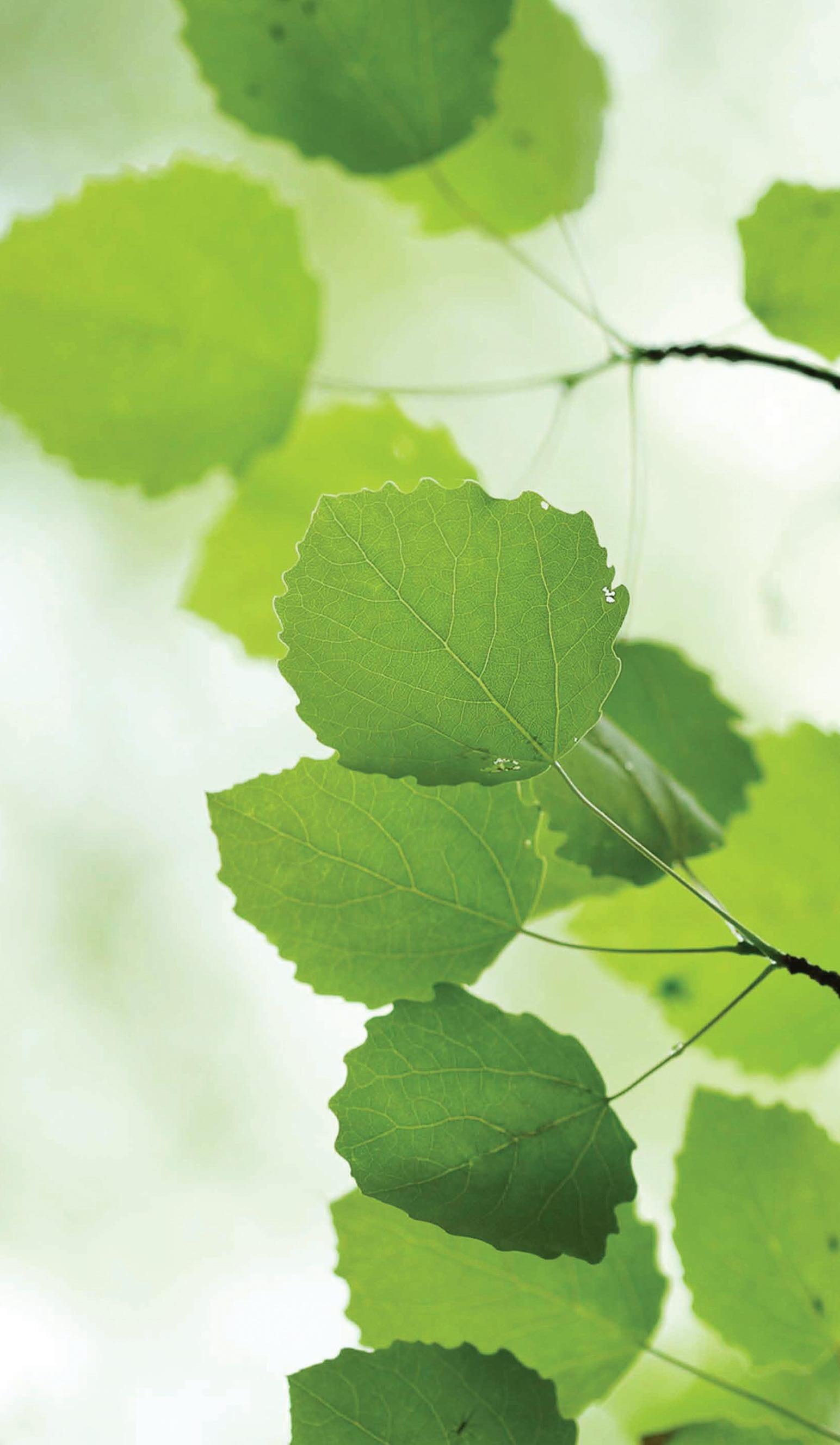
Verification by the ABA:
✓ Confirms that claims of conformance to standards are valid
✓ Provides an easy way to check conformance via the website
✓ Gives assurance items will compost or soil biodegrade as claimed
AS 4736-2006 certified items:
✓ are suitable for composting and other microbial treatment
✓ meet the requirements of AS 4736
✓ contain no added PFAS
✓ have passed the earthworm ‘ecotoxicity’ test
AS 5810-2010 certified items:
✓ are suitable for home composting
✓ meet the requirements of AS 5810
✓ contain no added PFAS
✓ have passed the earthworm ‘ecotoxicity’ test

ISO 23517 certified items: meet the requirements of the international soil biodegradable standard have passed the earthworm ‘ecotoxicity’ test biodegrade in-situ, no removal required
✓ biodegrade to CO2, water, and biomass with no detrimental effects
Visit our website to find out more
www.bioplastics.org.au
Elliot Nuberg, Delta Group’s South Australia State Manager, says partnerships like the one with ResourceCo help meet recycling and reuse targets on major projects.

Embrace Local Excellence with the Australian-Made 20-Tonne Hook Loader, Championing Homegrown Manufacturing. Invest in Quality, Support Local, and Stay Ahead! visit HSRSX.com.au or call 02 9725 3347 to learn more 39 Holbeche Rd, Arndell Park, NSW 2148 39 Advantage Ave Morisset NSW 2264 admin@hsrsx.com.au Elevate your operations: Unleash the power of Australian-Made Hook Loaders!
Providing plastic pipe power
The importance of pipes to Australia’s way of life is often underestimated. The Plastic Industries Pipe Association (PIPA) is working to change that.

It’s hard to comprehend the vast network of plastic pipelines installed and in operation in Australia and worldwide. Most are buried and have been in service for more than 100 years.
Plastic pipes have many advantages over alternative materials and with the increased global focus on reducing the environmental footprint and transitioning from a linear to a circular economy, they are increasingly becoming the preferred material to replace and upgrade pipes.
Aligning with the fundamental principles of a circular economy, plastic pipes are designed to minimise waste and pollution, last a long time, and can be repaired and recycled.
PIPA’s Executive General Manager, Cindy Bray, says one of the important features of plastic pipes is their design life. ey are intended and designed to last a long time.
“In typical environmental conditions, plastic materials are well known to last for a very long time,” Cindy says. “ ey often remain functional for more than 100 years without requiring excess maintenance or repair when used and installed correctly in normal operation.”
As a non-pro t association, PIPA promotes the appropriate and contemporary use of plastic pipes and ttings throughout Australia. is achieves its four key pillars: advocacy, education, technical, and sustainability.
One key focus area for PIPA is educating people on the di erences between plastic pipes, ttings, and other plastics, such as single-use plastics.
“Not all plastics are the same, and too often, plastic pipe systems are mistakenly put in the same category as single-use plastics,” Cindy says. “Pipes are longlife products, not single-use, made from
materials engineered to be robust, reliable, and recyclable with a service life over 100 years.”
To help further educate on the positive use of plastics, PIPA has recently launched a digital campaign, at’s using plastic for good.
It’s an awareness campaign targeted at those outside the industry –di erentiating plastic pipes from single-use plastic and highlighting their indispensable role in everyday lives.
Most plastic pipes have exceptional service lives and are still in their rst life cycle. is makes comparisons between annual plastic consumption and total annual plastic recovery misleading for plastic pipes and ttings.
PIPA and its members are acutely aware of the problem society faces with plastic pollution, and for more than two decades, the industry has aimed to recycle the maximum amount of usable plastic pipe and other suitable materials into new plastic pipes.
“We are committed to maximising the use of post-consumer and pre-consumer recycled content in products while ensuring that products remain t-forpurpose,” Cindy says.
“Pipes manufactured with recycled content must conform to the relevant Australian Product Standards, just like those manufactured from virgin materials. is is particularly important in infrastructure applications where reliable performance and long service life are primary considerations. Plastic pipes
WASTE MANAGEMENT IN ACTION � PLASTIC PIPES www.wastemanagementreview.com.au / WMR / 35
Images: PIPA
The Construction Plastics Recycling Scheme will launch into phase three, expanding across 40 locations.

must be t-for-purpose, regardless of their composition.”
USE OF RECYCLED MATERIAL
PIPA published a discussion paper on using recycled materials in plastic pipes to help educate people. is paper outlines where recycled materials can be incorporated in plastic pipes and their sustainability advantages, addresses misleading comparisons of virgin and recycled material, and explains how they are long-lasting products.
Further, PIPA has developed Industry Technical Guidelines POP208, Speci cation and Testing Guidelines for recycled materials suitable for non-pressure plastic pipe applications. is document de nes speci cation and testing requirements for recycled materials and products that incorporate recycled material, outlining the characteristics and performance criteria required when using recycled materials. ese documents are available on the PIPA website.
“ is guidance is extremely important to ensure recovered materials are reprocessed correctly,” Cindy says. “It’s a valuable resource that we want to use. It’s also important for the end product to have a long service life.”
IMPROVING SUSTAINABILITY
Although there is a low volume to recover due to the long life and integrity of plastic pipe systems, PIPA and its members are
taking practical, meaningful steps to minimise the impact of plastic pollution. It is working with the broader industry to divert suitable plastic material from land lls into long-life, recycled pipe products that meet the relevant Australian and International Standards.
ere is already capacity to increase the use of recycled material across a range of non-pressure pipe products when suitable waste stream volumes become available –PIPA already has the solution.
An example of this is within PVC non-pressure pipes. Multi-layer extrusion technology (or sandwich construction) allows recycled material to be used in the core layer of the pipe (the middle) between the inner and outer layers of virgin material. Recycled material can
also be incorporated into non-pressure polyethylene pipes, such as corrugated drainage pipes.
e plastic pipe industry is proud of its environmental sustainability initiatives, which include best-practice material sourcing and manufacturing (with processes designed to reuse scrap materials to make other pipes), end-of-life product stewardship, and recycling programs.
With the various applications in which plastic pipes are used, there are many approaches to collection, with some more challenging than others. PIPA has established a Plastic Pipes Recycling Program with various partners across Australia that provides information and locations for end users to deliver the pipes and ttings they no longer need.
PILOT PROGRAMS
PIPA has engaged with other industry stakeholders within the plumbing sector, including the Master Plumbers Association of Queensland (MPAQ), to establish education and pilot programs to increase awareness of the sustainability of plastic pipes and develop behaviours for appropriate disposal of o -cuts.
“Programs such as the Construction Plastics Recycling Scheme in Queensland not only educate but also provide the industry with insights into behaviours and

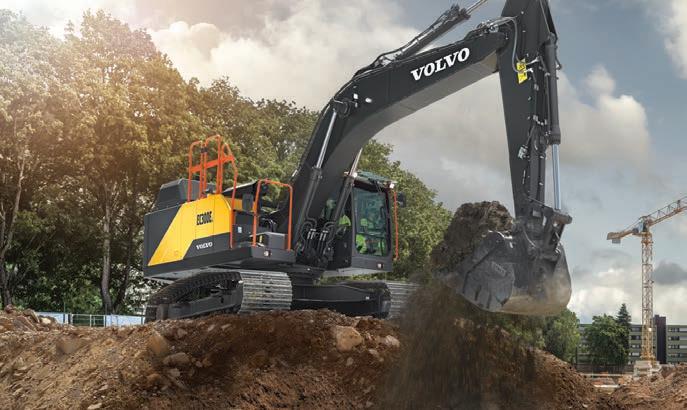
WASTE MANAGEMENT IN ACTION � PLASTIC PIPES 36 � WMR � May 2024
PIPA has produced an industry guideline for recycled materials suitable for non-pressure plastic pipes.
Education is important. Through the Construction Plastics Recycling Scheme (PIPA) and MPAQ visit TAFEs and training colleges to speak about recycling PVC pipes and fittings.
a greater understanding of the volume of available plastic pipe o -cuts and ttings from buildings, construction sites, and education training facilities,” Cindy says.
“ is data will enable us to paint a true picture of the available material, expand these programs, and support better consumer investment and policy decisions.”
e Construction Plastics Recycling Scheme is about to launch phase three, expanding to 40 locations, including regional areas. is initiative is supported by the Queensland Government’s Recycling and Jobs Fund.
Cindy says the success of these programs can only be achieved through the collaboration of key stakeholders from industry associations, manufacturers, and merchants to end users.
ese programs provide PIPA and MPAQ with the opportunity to visit
TAFEs and training colleges, speak with apprentices at the beginning of their careers about the sustainability and recyclability of plastic pipes, and encourage them to continue the conversation about appropriate disposal when they are out of the classroom and back on site.
PIPA has also teamed up with Cool. Org, a company that brings real-world learning into classrooms. It provides free lesson plans mapped to relevant year levels and the Australian curriculum, which is centred around environmental, social, economic, and sustainability topics.
“I’m really proud of this partnership,” says Cindy.
“We’ve developed 10 lessons designed for Grade 5-6 students in the subject of design and technology, focusing on circularity and the good use of plastic. ese lessons introduce design thinking,



how pipes are used in our everyday lives, the suitability of pipe materials, material e ciency, and recycling. e project provides another opportunity for us to educate on the positive use of plastics.”
rough the whole lifecycle –manufacturing, use and disposal – the plastic pipe industry has maintained a commitment to improving sustainable practices and outcomes in a way that bene ts all Australians.
“Australia’s vast landscapes require largescale, special-purpose systems to move water, wastewater, and gas and protect underground power and communication cable networks,” Cindy says. “Plastic pipeline systems are robust and longlasting, providing reliability now and into the future.”
For more information, visit www.pipa.com.au

Bonus upgrade to 3-year/6000 hour component warranty and free 3-year Volvo Active Care subscription is valid for every new 14-35 tonne Volvo excavator purchased between 1st January 2024 and 30th June 2024. Offer available on new Volvo excavator models EC140D, EC140E, ECR145E, EC220D, EC220E, ECR235E, EC250D, EC250E, EC300D, EC300E, EC350D, EC350E, ECR355E, including Dig Assist and hybrid models (excludes Volvo wheeled excavators). Machine must be delivered by 31st of August 2024. Warranty is valid on component only. The warranty is limited to three years or 6000 operating hours, whichever occurs first, commencing from the date of delivery. Normal manufacturer’s warranty terms and conditions apply. Images are for illustration purposes only. CJD Equipment reserves the right to withdraw this offer at any time without notice. CJD.COM.AU | 1300 139 804 | ENQUIRIES@CJD.COM.AU CONTACT YOUR LOCAL BRANCH FOR MORE INFORMATION Big Enough to Trust, Small Enough to Care bonus 3-year support package * 3-YEAR ACTIVECARE CONNECTIVITY Package 3-year
hour extended warranty & Purchase a new Volvo 14-35 tonne excavator between 1 January - 30 June 2024 and receive extra piece of mind with an extended 3-year/6000 hour warranty and a bonus 3-year Active Care Subscription.
/6000

Waste levy windfall
Resource Hub is helping local government areas across Australia uncover hidden opportunities to recoup waste levies.
Waste levy exemptions don’t have to be complex. In fact, they can be quite simple; you just need to follow a process.
Establishing that process is where Lacey Webb, Resource Hub Founder and Chief Executive O cer, reigns supreme. Described as an extra set of hands behind the industry, Resource Hub thrives on crunching numbers and putting money back into council co ers.
Resource Hub supports waste operators and local government areas across Australia in becoming more nancially and operationally e ective and complying with waste levy and waste and resource recovery (WARR) regulations.
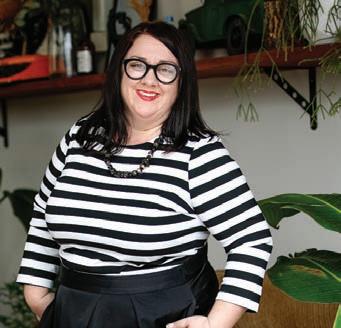
As the only dedicated waste levy consultancy in Australia, it is currently working with New South Wales councils to raise awareness of the importance of Operational Purpose Deductions (OPDs) – and with positive
results. e team recently clawed back more than $1 million for the Hawkesbury City Council.
“As a former chief nancial o cer, I am always focused on ensuring pro tability through the implementation of good processes,” Lacey says.
“Often process improvement is something people undervalue or under appreciate. But there are huge opportunities to save councils as much money as possible by being as e cient as possible. If my team can help save some coin, I’m up for it.”
Non waste materials are one such opportunity. e New South Wales waste levy doesn’t recognise nonwaste. Anything that comes in the
WASTE MANAGEMENT IN ACTION � CONSULTANTS 38 � WMR � May 2024
Resource Hub is helping local government areas comply with waste levy and waste and resource recovery (WARR) regulations. Images: Resource Hub
Lacey Webb, Resource Hub Founder and Chief Executive Officer.
gate at a land ll or disposal facility – virgin excavated materials, recycled aggregates, land ll cell liners and piping for leachate or gas are systems – is considered waste. Operators pay a levy on that waste if it remains on site.
But an OPD is the exemption or clawback that operators can apply for if material they paid a levy on was used for an operational purpose.
“It can add up to huge numbers,” Lacey says. “When building a land ll cell, the tonnes of material that facilities bring in are high and can amount to a signi cant nancial burden if not well managed.”
OPDs and anything related to the waste levy, behind-the-scenes administration, and regulatory compliance, often y under the radar in terms of facility focus. Often, this is because councils struggle to resource or don’t have internal expertise.
In the case of Hawkesbury, council has a waste co-ordinator who is skilled at nancial modelling and regulatory oversight. However, the two-year statutory limit to claim back OPD entitlements was close, and the team needed an extra set of hands.
“Hawkesbury council had already paid levy on material that wasn’t technically a waste,” Lacey says. “It was used to build land ll cells and infrastructure. We’ve been able to help them claim back more than $1 million that can now go back into helping build the next project. It goes back into council, and ratepayer, opportunities.”
Lacey says regulatory mechanisms that seem complex can often be simpli ed with templates and processes. At Hawkesbury, Resource Hub set up a repeatable tool for future claims.
Any time the council has work on site and needs to claw back that levy, the team can use their new templates to input raw data and pull out a summary. e template also helps build supporting evidence for the
Environment Protection Authority (EPA) when a claim is submitted and includes multiple reconciling factors to give the EPA con dence to approve faster.
While there is no statutory timeframe requirement for when an OPD application is assessed, the Hawkesbury submission was approved in under three months and every item claimed was approved.
“ e data, information gathering and crunching! It’s been a pleasure to work with Resource Hub and a great learning opportunity,” says Justin Murphy, Council’s Co-ordinator Waste Projects.
“OPD’s are not just about nances,” Lacey says. “ e process has helped Hawkesbury Council develop its relationship with the EPA, which will have broader bene ts.”
Resource Hub is building a transparent and working relationship with the regulatory authority in every state because it helps deliver great outcomes. Having a specialist third party assist councils also gives



www.wastemanagementreview.com.au / WMR / 39
Landfill cell construction.
Operational Purpose Deductions can be claimed for landfill cell construction.
projects including
and
OPDs
can relate to whole of site
cells
ponds.


authorities con dence that the data submitted for OPD applications is accurate and meets standards.
“When a regulator sees a solution that works or makes their assessment easier, they’re not hesitant,” Lacey says.
Resource Hub is currently supporting seven local governments within New South Wales to draft their OPD claims. In Hawkesbury’s case, their application dealt with ‘real numbers’ because the work had been completed. While more challenging, OPD applications can also be pre-emptive.
e bene t of a pre-construction claim is that facilities don’t require the cash ow for project levies up front. However, it does require solid predictions about the type and volume of materials to be used.
Kempsey Regional Council is currently working through the process of claiming historical OPDs but is also transitioning to a pre-construction approach in future.
Jason Magill, Kempsey Shire Council Waste Manager, says it’s good to know the council is now on the right track.
Lacey says the council was underresourced and was going through an internal restructure. It was working with the EPA when it identi ed projects for which OPDs hadn’t been claimed.
It’s a similar case at Byron Shire Council. e council realised a waste levy liability existed when it discovered construction materials used on site were considered a “levyable stockpile” in volumetric survey.
“OPD claims can y under the radar if councils don’t have the human resources or regular monthly routines to work on levy,” Lacey says.
“Resource Hub establishes a process to ensure weighbridge or volume data is appropriately structured. It’s often as simple as capturing transactions with real-time data of material coming in. Facilities also may not know to keep product sampling records to demonstrate that materials meet speci cations or may not have captured internal movements of material used.”
For Hawkesbury, Byron and Kempsey councils, the solution was providing a list of the type of projects and materials eligible for OPD, and the evidence needed for an application –the data, the plans, and even how best to provide photographs.
Lacey describes it as empowering councils on what to look for.
Four years after its founding, Resource Hub now supports all signi cant commercial land ll operators in Queensland and 80 per cent of the state’s waste levy local government market with their levy obligations.
In 2023, the team expanded services to include New South Wales and already has clients in Western Australia, South Australia, and Victoria. In 2024, the team has its sights on simplifying levy processes for Tasmania.
For more information, email: hello@resourcehub.com.au


WASTE MANAGEMENT IN ACTION � CONSULTANTS 40 � WMR � May 2024
Materials used by local government and waste operators to build landfill cells and infrastructure are not technically a waste.
solid
and
Supporting documents for OPDs can include plans or aerial views.
Pre-construction claims require
predictions about the type
volume of materials to be used.





Our solutions are based on efficient and environmentally sound in-house technology, and cover the entire life cycle of an Energy-from-Waste facility. Our proven technologies have been part of more than 700 plants worldwide. As a global leader in energy from waste we are proud to be able to say: We deliver. Check our references. Waste is our Energy www.hz-inova.com
Rely
London, Oslo and Dublin
on Our Energy-from-Waste Technology. So Does Perth.
Game-changing
In-house manufacturing helps Liebherr specialist machines shift with industry.

The recycling and resource recovery industry is undergoing rapid transformation. Once general disposal companies are now specialised recycling operations. is evolution has reverberated across the sector – right down to the machinery it uses.
Global equipment manufacturer Liebherr has developed signi cant technological enhancements in its equipment, using many years of experience and world recognised sustainability and environmental focus. In Australia, that means only the latest technology that can withstand the harsh Australian conditions.
Noel Tosolini, Liebherr Australia’s National Sales Manager, Earthmoving and Material Handling Division, says Liebherr’s advantage is its inhouse manufacturing.
“All key components: diesel engine, hydraulic and electronic components, slew ring, swivel drive and steel structure are developed, tested and produced by Liebherr providing a high level of quality assurance and long service life,” Noel says. “Even during development, the requirements of future applications are taken into account to ensure that Liebherr specialist machines are prepared for every feasible working situation.”
Liebherr-Australia was rst incorporated as a company in 1981 and its head o ce complex in Adelaide was built soon after. Since then, the company has expanded with o ces throughout the country.
Today Liebherr-Australia sells and supports a wide range of Liebherr products in Australia and New Zealand including mobile and crawler cranes, o shore cranes, tower cranes, deep foundation machines, earthmoving and mining equipment.
In addition to the sales and services o ered, the Adelaide, Perth, Mackay, and Mt orley sites are home to bucket manufacturing and bucket repair facilities.
e company also operates a national distribution centre and a remanufacturing centre. Both are established to provide industry best practise standards of remanufactured components and parts for customer eets.
When it comes to material handling equipment, Liebherr o ers a variety of machines and technologies that are custom engineered for these applications. From material handlers, wheel loaders to dozers, crawler loaders and more, Liebherr provides customers capable and e cient machines.
MATERIAL HANDLERS
Noel says Liebherr material handlers are powerful, e cient and adept at a range of tasks in the waste sector: feeding a conditioner or crusher, loading and unloading, sorting materials and piling up and moving materials of all kinds.
He says the optimal interaction between the material handler’s
WASTE MANAGEMENT IN ACTION � MACHINERY 42 � WMR � May 2024
The L 566 XPower Wheel Loader offers faster loading cycles and high tipping loads to increase material handling capacity. Images: Liebherr
hydraulics and electronics provides fast and powerful movements. At the same time, it’s also up to the task of sensitive and precise work in challenging sorting environments.
“Liebherr achieves this di cult balancing act with its own engine technology manufactured in-house and optimised to meet the requirements of controlled hydraulics,” Noel says.
“State-of-the-art engine technology, with intelligent machine controls, optimise the interplay of the drive components in terms of e ciency. Add in the Liebherr-Power E ciency (LPE), that enables machine operation with the lowest possible fuel use, and you’ve got greater e ciency with maximum performance.”
e material handlers are sturdy and durable, even in challenging waste management operations, including land lls. Air lters with dust extraction, reversible fans or coarse matrix radiators, have been developed for deployment in areas heavily contaminated with dust, providing reliability under demanding conditions.
e cab has been designed to optimise operator comfort and e ciency. Large glass panels, a choice of cab elevations and rear and side monitoring ensure the operator always has a clear view around the machine. In addition, the Comfort driver’s seat, intuitive touchscreen colour display and central lubrication systems for the machine and its attachment allow the operator to concentrate on the handling capacity.
e design also optimises servicing times, thus minimising maintenance costs. Maintenance points are easily accessible via large, wide-opening service doors. Being close to one another means that service work can be completed quickly and e ciently.
WHEEL LOADERS
e versatility and range of Liebherr wheel loaders has made them a preferred
choice across waste management and recycling operations.
In addition to various models, the L 550-L 566 XPower wheel loaders and the L 580 XPower now o er industrial and z-bar kinematics.
“ is means the right machine is always available for any application, including loading and compacting bulk goods in high walking oor containers,” Noel says. “It increases the wheel loader’s versatility and increases productivity.”
He says the innovative drive concepts of Liebherr wheel loaders reduce fuel consumption by up to 30 per cent.
means more safety and productivity.
e Liebherr control lever allows precise and sensitive control of the machine for accurate and safe handling. e generous glass surfaces of the cab o er all-round visibility.
All service points for daily maintenance can be reached safely and conveniently.
DOZERS
Noel says Liebherr dozers open new horizons. Ideal for pushing, shredding, mixing, stockpiling, and distributing waste types on a land ll, full power
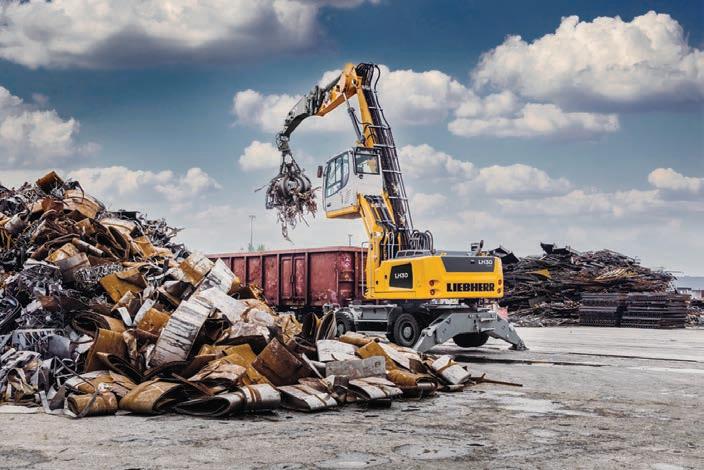
In addition, minimal tyre and brake wear, at maximum handling capacity, reduce operating costs and protect the environment.
“Liebherr wheel loaders satisfy Liebherr’s exacting standards in even the toughest conditions,” Noel says. “ ey feature many components that are produced in-house and are therefore ideally tailored to work in synergy. is ensures machine reliability and availability.”
e modern, ergonomic cab provides operators with maximum comfort enabling them to concentrate on their work without fatigue, which again
is always on-call, even in varying weather conditions and di erent grades of material.
e hydrostatic drive delivers the optimum pushing speed and low fuel consumption, while the innovative cooling system enables the radiator to self-clean, lowering maintenance and fuel costs.
Operator Assistance Systems guarantee maximum grading quality and e ciency, and a range of optional equipment is available to protect and extend the life of the undercarriage and other components.
Noel says Liebherr dozers feature a range of protective guards for land ll
www.wastemanagementreview.com.au / WMR / 43
The overall stability of the LH 30 M ensures a fast, powerful performance for lifting and loading work.

applications that prevent damage to the machine caused by oversized solid items. ey also reduce dust and dirt contamination, both prolonging the service life of the machines and preventing unnecessary downtime. A spacious and comfortable cab provides a full view of the working area and equipment while the single lever control system allows the machine to be controlled safely and precisely.
CRAWLER LOADERS
Whether it’s household or natural waste – Noel says Liebherr crawler loaders have proven to be all-rounders in the construction phase, as well as in the operating and renovation phase. ey can be used for the installation and pre-compaction of waste, as well as application of surface layers, material handling and auxiliary work.
“Crawler loaders, with their high breaking forces, are indispensable for sorting out bulky waste fractions or excavating loamy or frozen soil,” Noel says. “ eir unmatched traction on unstable ground bene ts them when pushing garbage, working on embankments or recovering trucks that have got caught.”
Due to their versatility, minimal maintenance requirements and low fuel consumption, Liebherr crawler loaders are suitable as universal machines for smaller land lls or as an integral part of the vehicle eet at larger land lls.
e bucket shape and volume, as well as the grid and cutting tool, can be adapted to the general conditions of quality of the waste and cover material at the land ll.
As an option, the machine can also be equipped with a rear ripper. e
demand-driven hydraulics and reduced engine speed in ECO mode further reduce fuel consumption.
e pressurised cab with air conditioning, sound insulation, airsuspended seat, hydraulic cab suspension and optional windshield protection o ers good conditions for safe, relaxed and productive work.
e intuitive, sensitive single-lever control, and unobstructed view, allow the operator to concentrate on their work.
Long maintenance intervals and easily accessible service points are of importance for machines used in intensive continuous operation such as land ll sites, ensuring they are ready for use at all times.
For more information, visit: www.liebherr.com.au
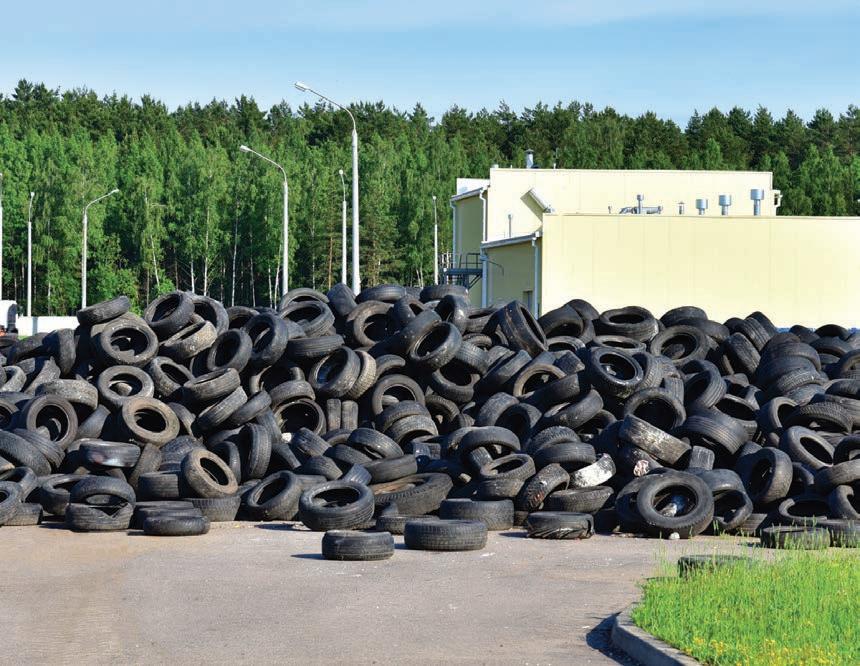
44 � WMR � May 2024 WASTE MANAGEMENT IN ACTION � MACHINERY
Liebherr dozers offer a smooth ride and precision blade control. Image: Liebherr
WASTE INNOVATION & RECYCLING AWARDS
Recognising excellence across the waste and resource recovery sector. Sponsorship opportunities are now available for 2024.
www.wasteawards.com.au




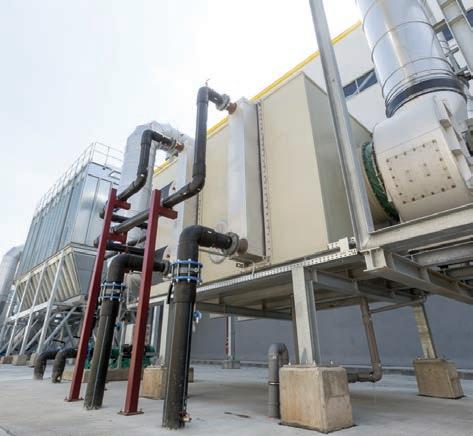
23 OCTOBER 2024 | MELBOURNE
CONTACT CHELSEA DANIEL chelsea.daniel@primecreative.com.au +61 425 699 878 SPONSORS
A FORCE to reckon with
Bucher Municipal demonstrates its new FORCE Series 3 front loader body on IVECO ACCO
Refuse collection equipment supplier and manufacturer Bucher Municipal has teamed up with IVECO for a national roadshow to showcase its new FORCE Series 3 Front Loader compactor body.
Following a 12-month development process and prototype testing, the new body has entered production with demonstrations of the vehicle proving popular with both local governments as well as private waste contractors.
A key feature of the FORCE Series 3 body is ‘Bucher iQ’, a new control technology that integrates with the cab chassis’ CANBus system and provides increased diagnostics and system con guration bene ts via a touchscreen interface.
It also introduces Bucher’s own hydraulics system, which the company designed and engineered speci cally for its bodies. Additionally, the new Bucher hydraulics have advanced anti-tamper technology and o er direct control from the operator screen while also delivering increased savings in maintenance and parts.
Available in 28.5 cubic metre and 33.5 cubic metre body sizes, the FORCE Series 3 makes the most of these capacities with its proprietary twin cylinder ‘ oating blade’ compaction system that provides higher compaction force, therefore allowing maximum payloads to be reached while minimising blade jams.
Also helping productivity is its ability to pack the load and pick up bins
simultaneously, and a 12-second lift cycle – this positions the FORCE Series 3 as a fast and productive front loader.
Marcus Hughes, Bucher Municipal’s Product and Marketing Manager, says the FORCE Series 3 delivers
features to operators over preceding FORCE models.
“ e FORCE Series 3 represents the latest evolution of the FORCE Front Loader range. is new model includes features that were developed

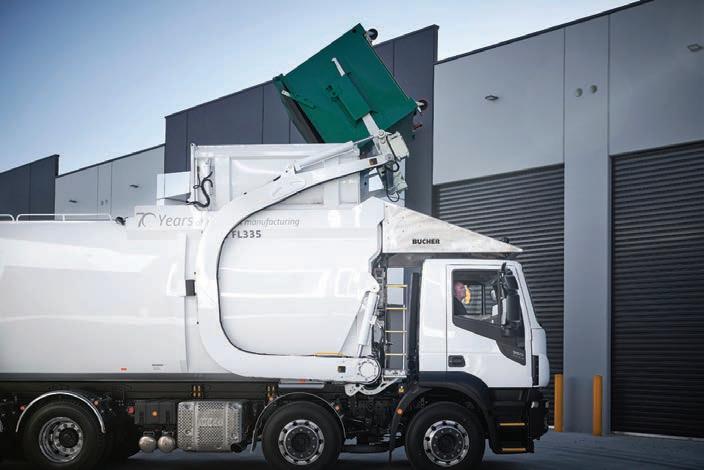

WASTE MANAGEMENT IN ACTION � TRANSPORT 46 � WMR � May 2024
The FORCE Series 3 represents the latest evolution of the FORCE Front Loader range. Images: Iveco
The ability to pack the load and pick-up bins simultaneously adds to the productivity of the FORCE Series 3.
following in- eld operator feedback as well as changes made through Bucher Municipal’s own product development processes,” Marcus says.
“Key focus areas of the new bodies centre on bringing the product in line with the Bucher iQ CANBus control system that has been so successful on our refuse product range, as well as improving usability while reducing servicing and maintenance costs.”
Bucher Municipal has enjoyed a strong relationship with IVECO and previously INTERNATIONAL for more than 50 years. Marcus says it was a logical choice to trial the prototype FORCE Series 3 Front Loader on an ACCO 8x4 platform.
“Our customers are very familiar with the ACCO range, for many of them
IVECO makes up a good portion of their waste collection eet,” he says.
“It’s a cab chassis that’s tried and tested, and one that our customers ask for, and for manufacturers such as Bucher, it’s an easy platform to work with.”
e FORCE Series 3 Front Loader roadshow involves a team from Bucher Municipal – including a driver trainer and product expert – visiting customer sites to undertake a detailed vehicle walkaround, followed by a physical demonstration.
Customers can then put the truck to work within their own eets for an agreed period of time.
e roadshow began in October 2023, and the unit will be available for demonstration until late in 2024.

Marcus says that feedback from participants has been excellent.
“Customers who have experienced the FORCE/ACCO combination recognise the considerable advancements that we’ve made, and interest has been strong.”
For more information, visit: www.iveco.com.au


Sustainable Generation® and GORE® Cover, setting the industry standard for odour control and sitewater management.
Odour reduction 90-99% (Odour emission study) • Protection of groundwater from contamination Waterproof GORE® Cover • Clear separation of leachate from stormwater
THORHOLD, ONTARIO CANADA - WALKER ENVIRONMENTAL GROUP, INC. with SG BUNKER® System and GORE Cover technology
A 12-second lift cycle positions the FORCE Series 3 as the fastest front loader in its class.
Prime position
From regional council landfills to large-scale, privately managed waste facilities, positioning technology is helping to extend the life of landfill cells and ensure high standards of sustainable waste management.
Aptella is a technology provider servicing the waste sector, construction, mining, and other heavy industry with the latest in positioning and automation innovation from around the world. Newly rebranded from Position Partners, the new name and identity better re ects its service o ering to customers.
“ e Position Partners name and brand has served us well,” says Martin Nix, Chief Executive O cer. “Sentiment from our employees and customers was that the time was right for a fresh new identity to better represent the experiences people can expect from us as their vital technology provider.”
As emerging systems develop in automation, robotics, and augmented positioning for smart cities, the Aptella team will continue to work collaboratively to understand project
challenges and opportunities, innovate solutions and partner with customers for the long term.
In the waste sector, Aptella supports about 40 sites throughout Australia and New Zealand with machine guidance solutions that are designed for land ll operations.
“Our customers are varied in the scale, location and scope of the waste management facilities they manage,” says Andrew Granger, Executive Business Manager at Aptella. “Our technology platform is scalable and exible to bene t sites of all sizes, with local support across Australia and New Zealand to assist with technical deployment and ongoing maintenance.”
Aptella has o ces in every state and territory of Australia, as well as Auckland in New Zealand, Jakarta Indonesia, and Singapore. It employs more than 350
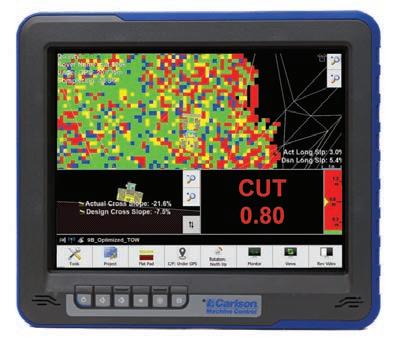
people with a range of skill sets to source, customise and support positioning and automation technology.
Carlson Land llGrade is a unique solution that the business has deployed for customers for more than 10 years. e system encompasses a GPS antenna
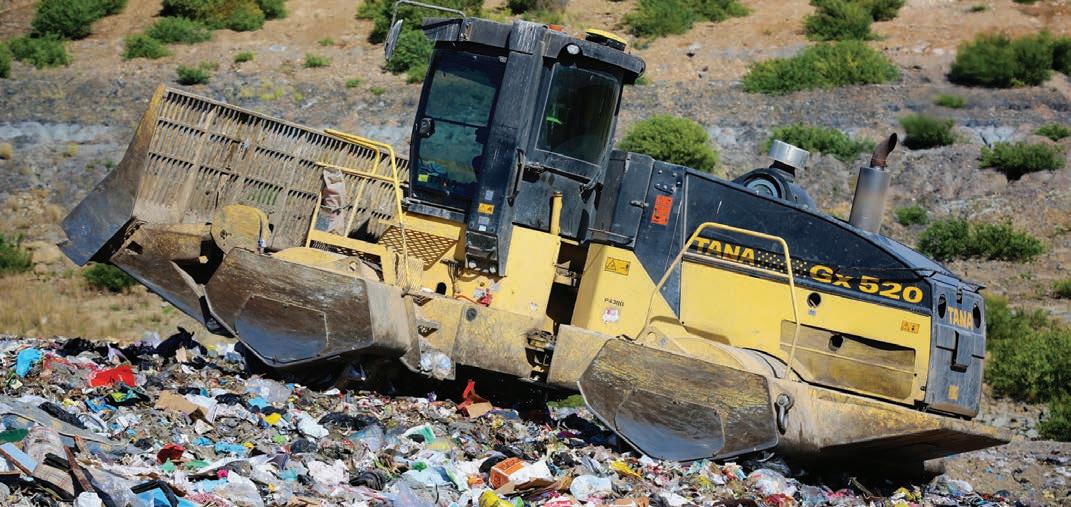
WASTE MANAGEMENT IN ACTION � MACHINE GUIDANCE 48 � WMR � May 2024
City of Newcastle landfill is one of 40 sites throughout Australia and New Zealand with machine guidance solutions. Images: Aptella
Carlson LandfillGrade gives operators live information on compaction, air space use and cut/fill design.
Image: Aptella.
mounted to the roof of the compactor, sensors on the machine body and a full-colour touchscreen inside the cab to guide the operator.
Designed to help land ll managers maximise the use of land ll cells dynamically rather than retrospectively, Land llGrade gives operators and managers live information on compaction, air space use and cut/ ll to design.
“Without the use of technology such as the Carlson system, operators and managers are somewhat ying blind because they can only measure what has been done with as-built checks,” Andrew says.
rough continuous monitoring of compaction and airspace use, the technology helps to ensure that slopes are graded accurately, and air pockets are minimised. Building the design right
the rst time with optimal compaction can extend the life of a land ll cell and improve leachate management, with less impact to the environment through reduced fuel usage and better air quality.
Improved safety is another key factor for deploying positioning technology.
e software can be programmed with avoidance zones, alerting operators via their in-cab display if they approach a no-go area or enter the working area of another machine.
For larger sites, Carlson can be installed on a range of machine types including dozers, graders and excavators, guiding everyone working to a design on site.
“Whether there’s a single land ll compactor or a eet of machines, the Carlson system can be installed on any make and model to give a consistent user experience for all operators,” Andrew says.
“After many years of successful deployment on a range of sites, the Carlson solution is robust and reliable. It’s an extremely stable platform that rarely needs any breakdown technical support.”
For the most part, technical assistance is required in the form of training and initial deployment.
“Our team is well-versed in change management and helping to train operators and managers to get the most out of their technology in the shortest timeframe,” Andrew says.
“We try to remove any barriers and can o er fully managed services whereby we provide the reports and manage the data so it’s more hands-o for the onsite team.”
For more information, visit: www.aptella.com
DELIVERING A GREENER FUTURE
Komptech CEA is a leading supplier of machinery and systems for the treatment of solid waste through mechanical and mechanical biological treatments, as well as the treatment of biomass as a renewable energy source. Komptech CEA is proud to provide innovative solutions for handling waste and biomass.

Komptech CEA’s extensive range of products cover all key processing steps in modern waste handling. At Komptech CEA the focus is always on innovative technology and solutions ensuring maximum benefit to the customer. Like to know more? why not speak to one of our team today?

TERMINATOR
Where Function Meets Technology
A slow-running, single-shaft shredder suited to all types of waste.

CRAMBO
Less Fuel, More Power
Ideal for shredding all types of wood and green cuttings.

MULTI STAR
Screening with a Star
Makes waste wood and biomass processing highly efficient

TOPTURN X
The Ideal Combination of Performance and Design
With a sturdy frame, powerful hydraulics and large drum, the Topturn X is ready to handle any work situation.

NEMUS
Robust and Reliable
Combining the practice-proven virtues of its predecessors with new solutions for even greater performance

HURRIKAN S
Enhancing the quality of the recyclable output.
Providing effective removal of plastic film from screen overflow.


komptechcea.com.au
1300 788 757
WASTE MANAGEMENT IN ACTION � MACHINE GUIDANCE
Upgraded new model
entering market
The Australian waste management industry is about to be shaken up with the arrival of a monster compactor.
“With a mighty 58 tonnes in weight, the BOMAG BC 1173 RB-5 is one of the newest land ll compactors in our eet,” says John Glossat. “Five of these beasts will be reaching Australian shores shortly.”
Tutt Bryant Equipment has distributed BOMAG in Australia since the two companies partnered in 1986. John Glossat, the Tutt Bryant National Business Development Manager, is enthusiastic about what BOMAG’s latest o ering can o er Australian land ll operators.
e land ll compactor has many convincing design features that have been tried and tested over decades of practical use on land ll sites. With a philosophy based on quality, it is up to the challenge
of working on modern land ll sites.
“When it comes down to it, the best compaction results are achieved when the material is evenly distributed,” says John. “Compaction is a signi cant contributor to the lifetime of any land ll. Not only that, but every additional cubic metre lled is money in the bank for waste disposal sites.”
THE BOMAG BC 1173 RB�5
e BOMAG BC 1173 RB-5 refuse compactor o ers power and e ciency. Its intelligent design produces cost-e ective compaction with minimum maintenance work. e high-output diesel engine provides ample power for all conditions.
BOMAG emphasises sustainability. In conjunction with the latest engine
technology, the cooling system enables the BC 1173 RB-5 to operate quietly and provide a good working environment for the operator and the surrounding area.
e unit uses polygon disc wheels tted with premium teeth for crushing, kneading and e ective compaction to depth. An oscillating articulation joint provides good load distribution to the compaction wheels, while scrapers and wire cutters guarantee clean wheels during operation. e o set wheels ensure gaps in the covered area are closed evenly on a second pass.
ere is enough diesel power tted with a Cummins X15 engine as Tier 3 or Stage V to provide power for all conditions, while lower fuel consumption means lower operating costs.
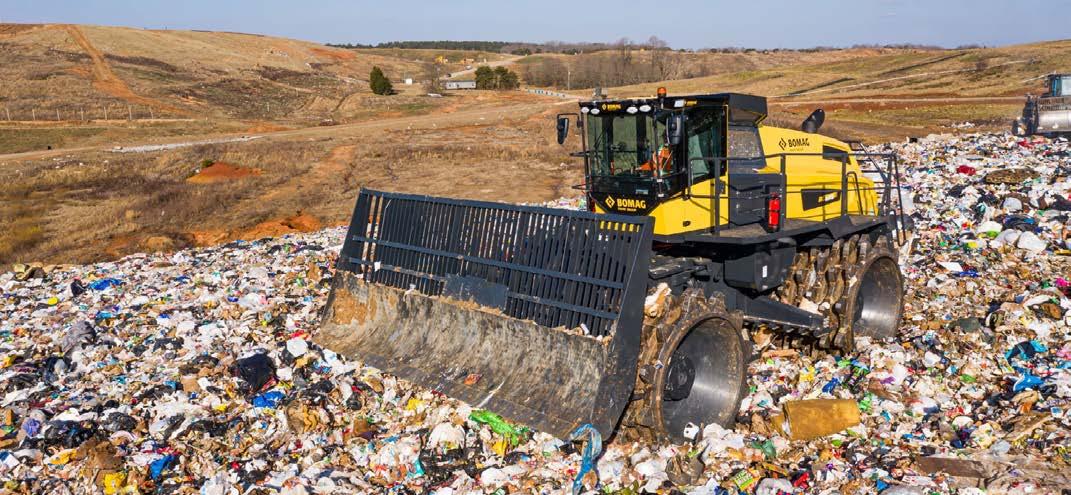

WASTE MANAGEMENT IN ACTION � COMPACTORS 50 � WMR � May 2024
The BOMAG BC 1173 RB-5 is an enormous landfill compactor that can support almost any waste management facility. Image: BOMAG
According to BOMAG, Eco Mode reduces fuel consumption by up to 30 per cent, and lower engine speeds minimise wear on drive components. is can extend the machine’s and its parts’ life.
“We also o er an option to have the machine tted with a Mercedes Benz MTU OM473LA Stage V Tier 4f if preferred,” John says.
SAFE, SMART, COMFORTABLE
e compactors come equipped with a range of standard safety features, including a rear-view camera with colour display, a ROPS/FOPS cabin with all-around safety glass, and large electronically adjustable mirrors.
John also likes the spacious BC 1173 RB-5 cabin, which features air conditioning, heating, an adjustable seat
with air-cushioned suspension, and is well-sealed for safety and noise reduction.
“It’s more comfortable than the lounge suite at home,” he says. “ e display is brilliant, easy to read, and the controller layout is great. Everything’s at your ngertips.”
e machine has innovative features, including telematics, cruise control, and BOMAG Autoblade and Blade Stepper. ese allow for the precise adjustment of dozer blade height to meet land ll requirements. ey also enable frequently used blade positions to be saved and retrieved anytime, streamlining operation.
“ e basis for a land ll’s pro tability is the optimum use of capacity, which you achieve through the best possible compaction of all waste materials,” John says. “BOMAG compactors get this right
because they’ve been speci cally designed by people who understand the extreme conditions found on land ll sites.”
THE AUSTRALIAN EXPERIENCE
Over the past few years, Tutt Bryant has mainly imported its compactors with premium teeth into Australia. e goal is to support crushing, compliance delivery, and longevity on wear. ey have been a proven asset.
Tutt Bryant Equipment is a premium BOMAG national dealer in Australia that focuses on its customers’ needs. It features strong after-sales support and parts and services to keep its eet rolling.
John says: “We are specialised, trained, and going the extra mile.”
For more information, visit: www.tuttbryant.com.au


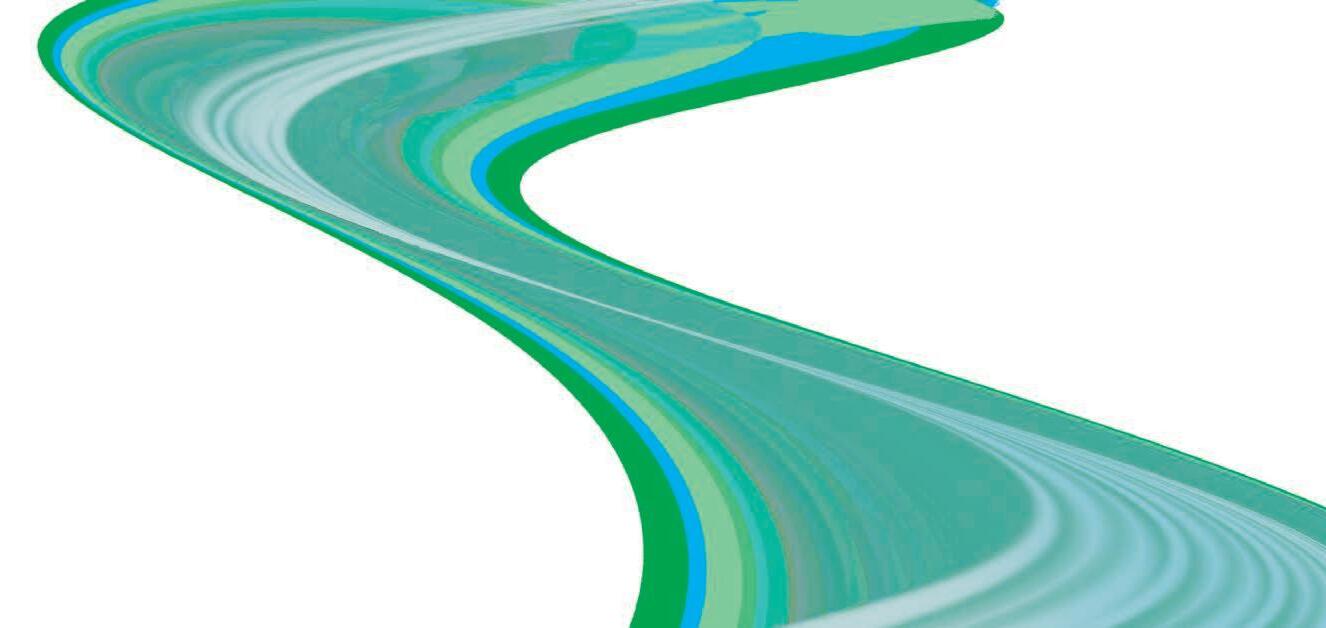
Thurs 20 June, 2024
WOMEN IN INDUSTRY NOMINATIONS ARE NOW OPEN. Now is your chance to nominate an industry leader who you believe is advocating for positive change and deserves to be recognised.
The Women in Industry Awards recognise outstanding women leaders from across Australia’s industrials sector.
womeninindustry.com.au
DO
OF CHANGE?
PRESENTED BY MHD upply PROUDLY SUPPORTED BY Australia
YOU KNOW A DRIVER
PROUDLY


WASTECH ENGINEERING, FIRE ROVER FIRE PREVENTION SYSTEM
Fires are one of the most prevalent risks in waste management facilities. Waste and recyclable materials can be highly flammable, without the additional risk factors now caused by lithium-ion batteries.
The Fire Rover Fire Prevention System is engineered with industry-leading technology to help keep sites safe. The system uses military-grade thermal detection and high-definition video to detect and extinguish the threat of fires before they start.
Advanced analytics pinpoint and identify hotspots before flare-ups. This information is assessed by sophisticated false alarm filtering analytics before human verification.
Upon verification, live-monitoring personnel engage the system, delivering significant volumes of water and environmentally friendly fire suppression solutions.
The automated system is suitable for a range of applications, from manufacturing and high-risk distribution centres to refineries and waste and recycling facilities. It can be deployed across all classes of fire such as agricultural, battery, metal, plastic, petroleum and waste.
The Fire Rover Prevention System offers protection and safety against the risk of fire so businesses can focus on operations.
KOMATSU, WA500�8 WHEEL LOADER
Powered by a new technology Komatsu engine, the 6.4 cubic metre capacity WA500-8 is designed for production and sales loading applications in quarry and aggregates sectors, as well as other industries that need a loading tool that delivers power and performance.
Key components are designed and manufactured by Komatsu to work together in an integrated package. The WA500-8 comes standard with Komtrax remote monitoring and location system, backed by Komatsu’s Australia-wide service and support network.
Renowned for quality standards and reliability, Komatsu meets the demand placed on machines by the waste management industry with a range of options and modifications available. This provides the flexibility to adapt the Komatsu wheel loader range to the specific requirements of different waste handling applications and jobsite conditions.
Full waste specification or individual components are geared toward increased machine performance, availability, and efficiency.


www.wastemanagementreview.com.au / WMR / 53
Contact – Komatsu P 1300 566 287 E info@komatsu.com.au W www.komatsu.com.au
PRODUCT SPOTLIGHT Contact – Wastech Engineering P 1800 465 465 E info@wastech.com.au W www.wastech.com.au
WA500-8 Wheel Loader is adaptable to specific waste handling applications. Image: Komatsu
The Fire Rover Fire Prevention System. Image: Wastech Engineering
AGRICULTURE FARMING EDUCATION WASTE
MANAGEMENT RESOURCE MANAGEMENT
CONSERVATION MANUFACTURING RESOURCES
ENERGY HEALTH & SAFETY INFRASTRUCTURE
ENGINEERING MINING CONSTRUCTION
QUARRYING AGRICULTURE FARMING EDUCATION
WASTE MANAGEMENT RESOURCE MANAGEMENT
CONSERVATION MANUFACTURING RESOURCES
ENERGY HEALTH & SAFETY INFRASTRUCTURE
ENGINEERING MINING CONSTRUCTION
QUARRYING AGRICULTURE FARMING EDUCATION
WASTE MANAGEMENT RESOURCE MANAGEMENT
CONSERVATION MANUFACTURING RESOURCES
ENERGY HEALTH & SAFETY INFRASTRUCTURE
ENGINEERING MINING CONSTRUCTION
QUARRYING AGRICULTURE FARMING EDUCATION
WASTE MANAGEMENT RESOURCE MANAGEMENT

SEARCH FOR TOP INDUSTRY TALENT THROUGH OUR JOBS BOARD.
CONNECT WITH ALIGNED CANDIDATES.
BOOST YOUR CHANCES OF FINDING SKILLED APPLICANTS.
SCAN TO CREATE AN ACCOUNT TODAY AND DISCOVER YOUR PERFECT MATCH!
For organic waste processors, efficiency is paramount. Enter the Komptech Nemus trommel screen, designed to streamline operations without compromising performance. This user-friendly machine makes organic waste screening a breeze, allowing operators to focus on creating high-quality compost and mulch.
The Nemus prioritises operator ease of use. An intuitive control panel with clear visualisation simplifies the sorting process, minimising training time and maximising uptime. This is particularly beneficial for operations with seasonal staff or fluctuating workloads.
Furthermore, the Nemus boasts various features designed to enhance organic waste processing. A large, steep-walled hopper allows for continuous feeding, while an improved material feed system ensures a consistent flow of waste into the screening drum.
The high-performance discharge system precisely sorts screened materials, creating clean, high-quality compost and mulch piles. Finally, flexible discharge conveyors give operators greater control over material placement, reducing the need for additional handling equipment.
KOMPTECH CEA, HURRIKAN S WINDSIFTER
Light plastics and film wreaking havoc on your compost production? The Komptech Hurrikan S windsifter is a powerful ally. Boasting a unique “pressure-suction” process it removes light contaminants from screened waste, achieving a separation efficiency of up to 95 per cent.
The Hurrikan S’s secret weapon lies in its patented two-step “pressure-suction” process. A precisely directed stream of compressed air acts like a virtual knife, separating light materials from heavier organic matter. Two powerful suction blowers then take centre stage. Operators can fine tune the suction by adjusting blower speed, distance, and vent flaps to effectively capture and remove the targeted lightweight materials.
This approach reduces the time and effort required for manually removing contaminants, streamlining operations.
The Hurrikan S prioritises operator control. An electric drive system allows for precise adjustments to blower settings based on the specific composition of screened waste.
Optional features such as magnetic drums and stone separators further enhance the quality of recyclable outputs by removing inert, heavy objects.
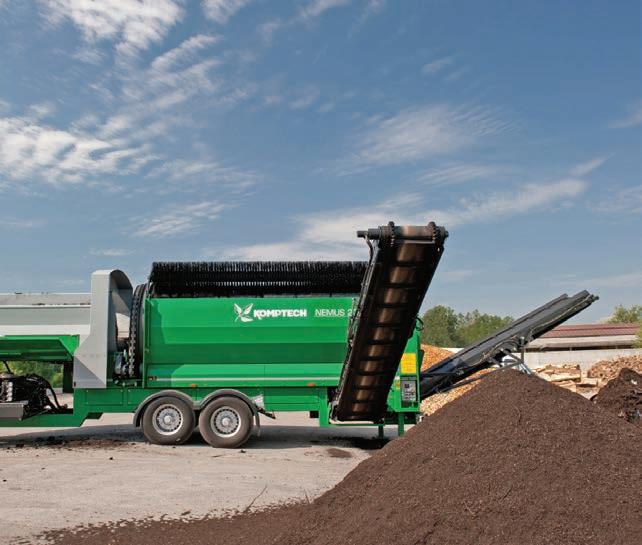
The Hurrikan S windsifter empowers processors to achieve higher throughput, produce cleaner compost, and contribute to a more sustainable waste management cycle.
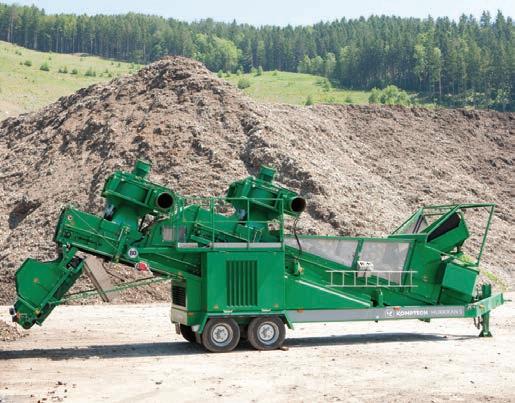
www.wastemanagementreview.com.au / WMR / 55
Contact – KOMPTECH CEA P 1300 788 757 E Marketadmin@cea.net.au W www.komptechceacom.au
PRODUCT SPOTLIGHT Contact – KOMPTECH CEA P 1300 788 757 E Marketadmin@cea.net.au W www.komptechceacom.au
KOMPTEC CEA, NEMUS TROMMEL SCREEN
The Komptech Nemus 2700. Image: Komptech CEA
Komptech Hurrikan S Windsifter boasts a pressure-suction process. Image: Komptech CEA


AUSTRALIA’S NEW ONLINE PORTAL DEDICATED TO BUYING, SELLING AND HIRING WASTE AND RESOURCE RECOVERY EQUIPMENT. Whether it’s a skip loader, shredder, wash plant or excavator, this is your one-stop-shop for buying, selling and hiring a variety of machinery and equipment from both dealers and private sellers. Advertise on Waste Management Review Marketplace to reach the right buyer. For advertising opportunities, contact ben.coleman@primecreative.com.au or call 0466 545 664 BUY. SELL. HIRE. Scan the QR code to find out more. MARKETPL ACE


Collaboration key to circular solutions
Sustainability Victoria has a vision for Victoria to become the national leader of circular economy within three years.
How?
Chief Executive Officer Matt Genever explains.
As Victoria’s population continues to grow, so too does the strain on resources and the environment.
With the state set to swell to almost eight million residents over the coming decade, we face an increase in emissions from the production, use, consumption, and disposal of materials and waste.
It’s not just the environment that su ers. Material usage is grossly ine cient and according to the United Nations Environment Programme (UNEP) Global Waste Management Outlook 2024 report, management of household waste alone will cost the global economy a staggering USD $640.3 billion by 2050.
However, the report’s modelling shows that by taking waste prevention and management measures, costs could be limited to USD $270.2 billion by 2050. More importantly, projections show that a circular economy model could in fact lead to a full net gain of USD $108.5 billion per year.
Sustainability Victoria recognises the time for change is now, which is why it has a renewed focus on supporting Victoria’s transition to a circular economy. Its vision over the next three years is for Victoria to become the national leader of circular economy.
EMERGENCE OF CIRCULARITY
Australia already faces scrutiny for its high carbon dioxide emissions per capita and low material productivity

rates. As global policies and regulations increasingly prioritise low-emission, nature-positive materials, the nation’s international market competitiveness will decline. By shifting away from a linear system and embracing circularity, Australia reduces material-based emissions, reverses biodiversity loss, and restores precious natural capital.
Changing to a circular economy will not only reduce the growing negative impacts on the environment, it will also generate new economic opportunities.
A report by KPMG suggests that a circular economy in key sectors could
unlock a potential economic bene t of AUD $210 billion in gross domestic product (GDP) and create an additional 17,000 jobs for Australia by 2047-48. is economic bene t applies to the waste industry. Fostering innovation in waste-to-resource technologies, such as advanced recycling and remanufacturing processes, can create new revenue streams, stimulate job growth, and enhance competitiveness in global markets. According to Access Economics, for every job in land ll, there are 3.3 times more jobs in recycling.
LAST WORD www.wastemanagementreview.com.au / WMR / 57
Matt Genever, Sustainability Victoria Chief Executive Officer. Image: Sustainability Victoria
“The investments have leveraged almost $333 million in private investment and $41.8 million in Federal Government investment, which are set to increase processing capacity by 34 per cent from 2020 to 2025.”
Matt Genever Sustainability Victoria Chief Executive Officer
MATCHMAKING FOR CHANGE
Realising the vision of a circular economy requires concerted e ort and collaboration from all sectors.
Sustainability Victoria’s plan to accelerate circularity on behalf of the Victorian Government is a crucial step in this journey.
By building the case, it can close the gap between recycling, design, and manufacturing, and drive the uptake of circular behaviours in communities. is will lay the groundwork for truly meaningful change.
e emphasis on collaboration underscores the importance of collective action in achieving shared goals. ere will need to be strong partnerships with industry, as well as collaboration with leading researchers and across wholeof government.
Sustainability Victoria is uniquely positioned to bring together a wide range of stakeholders to develop action plans that embed circular practices and deliver wide-ranging bene ts. is has been integral to how Sustainability Victoria has delivered innovation and impact over its long history – matching up ideas to funding and connecting the right technology to those keen to trial new techniques – so that local
markets and investments in Victoria grow, and those all-important recycled materials keep owing through to their next life and use.
Partnerships fostered to date across government, industry, business and universities are already delivering impact and building a foundation for a circular economy.
TRANSFORMING THE INDUSTRY
Circularity can’t ourish without a vibrant recycling sector. Materials re-entering the economy need to be genuine commodities, reliable and high in quality.
Investing in the right innovations, infrastructure, and technology is key for a circular transition, and Sustainability Victoria’s investment facilitation service is successfully matching prospective investors with circular economy opportunities.
e investments have leveraged almost $333 million in private investment and $41.8 million in Federal Government investment, which are set to increase processing capacity by 34 per cent from 2020 to 2025. A further 100 active investment cases valued at more than $3.7 billion are in the works, with the potential to add
4.97 million tonnes of capacity and more than 1360 jobs to the sector.
e organics sector is burgeoning and is receiving a critical injection of investment from Sustainability Victoria – not only to process higher volume, but to produce better outputs.
Biogro is establishing a Regional Organics Recovery Facility in the Bendigo region that will boost the capacity to process a diverse range of organic materials, while the funding of organics decontamination technology at Pinegro will enable a higher quality compost to be produced from kerbside food organics green organics (FOGO) and, at the same time, create new jobs.
But investment in new ideas is not without risk and that’s where Sustainability Victoria can provide support – it can partner with businesses to de-risk ideas, provide resources, information, training, networking and events – so businesses can connect, collaborate and learn from each other.
By building a foundation for a circular economy and accelerating new markets for recycled materials, as well as educating Victorians through statewide education and behaviour change campaigns, it can make the transition to a circular economy easier to navigate for all.
e scale and pace of change required is signi cant and needs all parts of business and community to get involved. Sustainability Victoria is committed to deepening partnerships, brokering new collaborations and to open dialogue and knowledge sharing as it supports industry to leverage the opportunities and tackle new challenges in the future circular economy. By working together, the state will have a brighter future, faster.
If you have an idea to test, a problem to solve, research questions to answer contact: www.sustainability.vic.gov.au/about-us/ contact-us

58 � WMR � May 2024 LAST WORD
ENGINEERED FOR A CIRCULAR ECONOMY

CDE is here to transform waste materials into valuable recycled products. Our innovative wash plants give you the power to divert tonnes of waste from landfill and create new revenue streams. Move into new, high-value markets, like certified, in spec concrete sand, recovered from CD&E waste.
For further information please scan QR code
Visit cdegroup.com
















 Lisa Korycki
Lisa Korycki





 Lacey Webb Chief Executive Officer
Lacey Webb Chief Executive Officer


































































































